Tag Archives for " marketing "

Everything You Should Know to Create a Useful Competitor Report
Analyzing and monitoring your competition is fundamental to any business’s success.
So what should a good competitive report include and how to take it from research to action?

Why Does My Business Need a Competitive Report?
There are many reasons why a business may need a competitive report, and all of these are valid:
- To better understand your target audience by researching how they find and engage with your more established competitor
- For market research: Understand what is currently available on the market and where your business fits inTo get an estimate of your future marketing budget
- To identify effective marketing tactics, etc.
Business owners that claim they don’t need a competitive report because they already know everything are clearly missing out. Competitive research is much more than copying your more successful competitor’s marketing tactics.
Actually, it is not at all about that because copying would never bring you ahead.
Competitive research is about understanding your target market and distinguishing your unique value proposition and consequently your unique marketing strategy to conquer it.

So what should a solid competitive report include?
Competitive Benchmarking
Competitive benchmarking means collecting the performance data of your competitors and comparing it to your business. It is used to measure and monitor your business’s performance against its competitors.
You can choose your own performance indicators to track and compare. These may include:
- Public traffic data (from tools like Ahrefs, Alexa, and Similar Web)
- Organic rankings
- Brand awareness and sentiment (based on brand mentions), etc.
This section in your report is going to always evolve but it is also fundamental because your whole competitive analysis will evolve based on KPIs you will identify as the most important for you.
Basic Overview of Competition
There are fundamental KPIs you are going to focus on and there are secondary metrics that will help you identify competitors to keep an eye on.
This section is about the latter. This basic section helps you look at your competitors’ secondary metrics at a glance to identify if there’s a definitive pattern to look deeper into:
- Backlinks
- Organic traffic
- Social media followers
- Social media engagement, etc.
- Tools like Ahrefs, Keyhole, and Similarweb will help you collect all the necessary data.
Detailed Dive into Organic Search Engine Optimization Tactics
Look at some key search engine optimization tactics your competitors are using:
- Which keywords are they focusing on?
- How are they optimizing their title tags and meta descriptions?
- Are they optimizing their old content and how often?
- What does their site architecture look like?
- How are they organizing their main navigation?
- What’s their internal linking strategy?
- What are their most successful pages (i.e. those that rank for the most competitive search queries)?
- What’s their semantic optimization strategy?
Try running a few of the most important pages through a tool called Text Optimizer to determine whether your competitors are doing a good job optimizing for search intent:
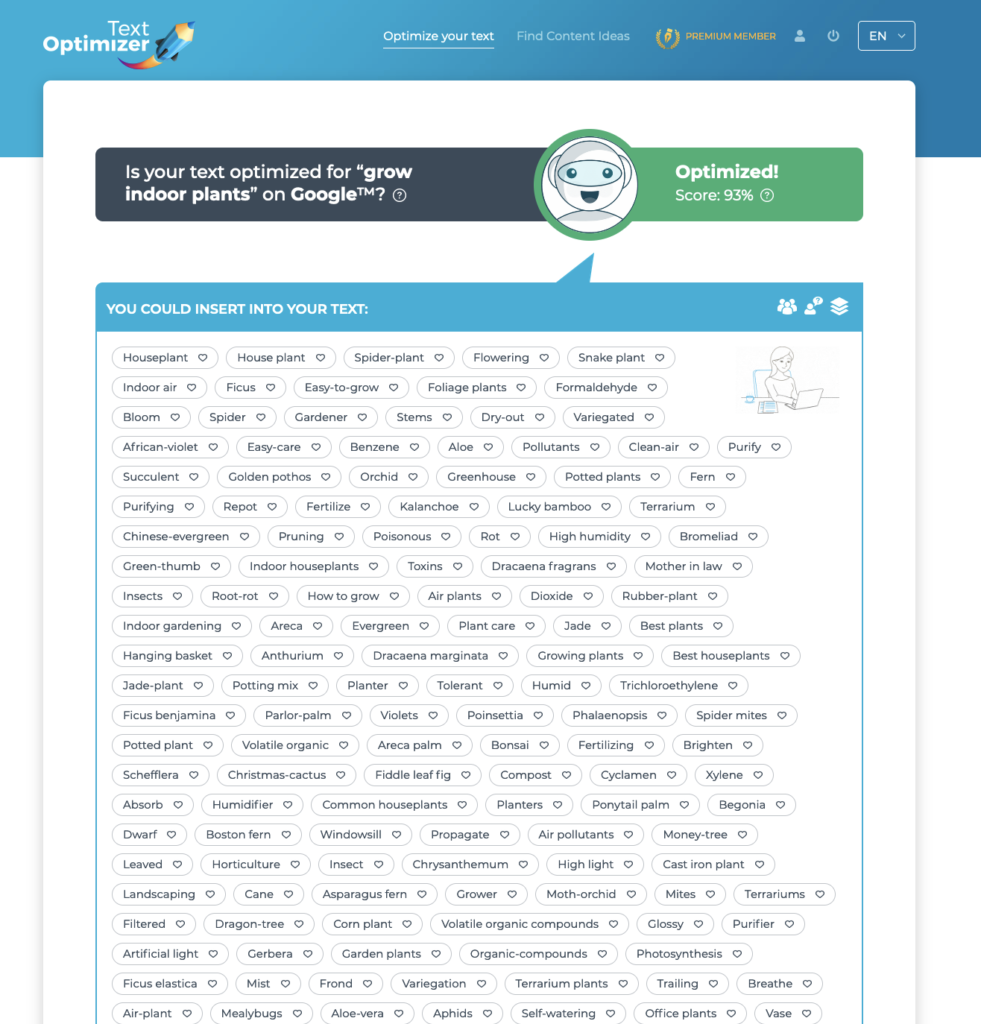
One of the most actionable steps here is to look at Content Gaps, i.e. researching which keywords your competitors are ranking but your site is not. This is a great way to expand your content strategy to include new keywords. Ahrefs provides this analysis, so it is both easy and effective:
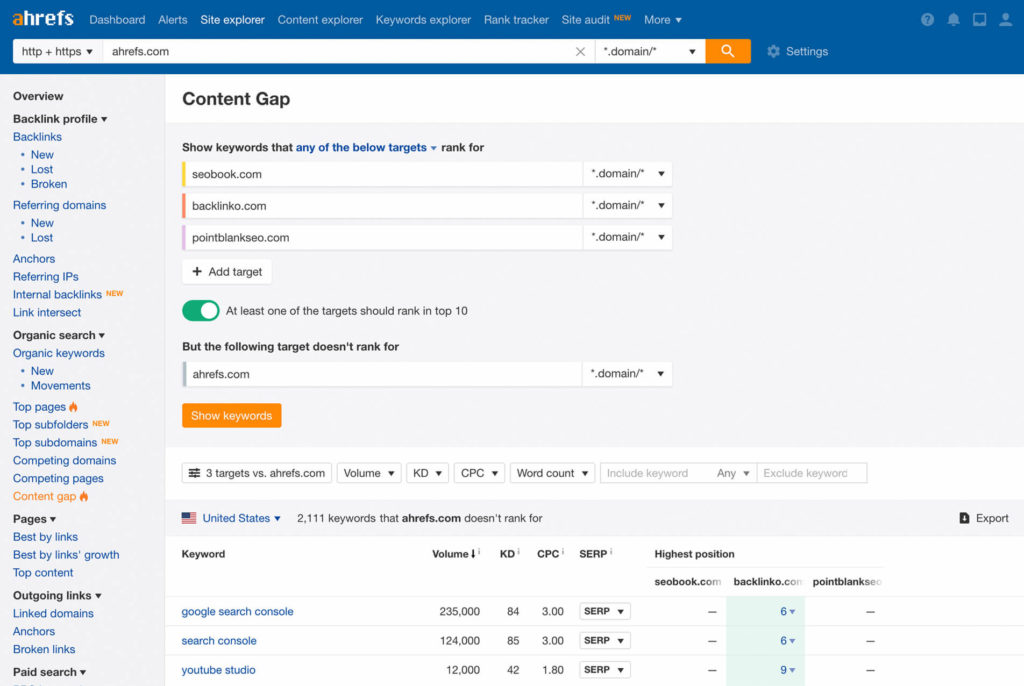
Competitors’ Backlink Research
Backlink research is important for many reasons but doesn’t just use it in an effort to “steal” some of those tactics or claim some of those links. Look at a bigger picture:
- Who are your competitors’ promoters (i.e. people who link to them) and how did your competitors win their hearts?
- Which PR tactics seemed to work best for your competitors and why?
- How are they utilizing content to generate backlinks?
The purpose of competitive backlink research is to understand what works for niche publishers and how you can build your own long-term relationships with them to outmatch your competitors in the long run.
There are quite a few backlink checking tools that would help you create this report.
Social Media Growth and Engagement
The first part of this section is, again, an overview giving you an idea on who to research further. Create a quick chart summarizing your competitors’ active social media channels, number of followers and friends, and their overall activity.
Keyhole can help you with that section:

Social Media Tactics to Take a Note of
Here I suggest highlighting some creative tactics your competitors are using on social media. Forget about numbers: Highlight what you found ingenious even if that didn’t yield obvious great results. Make lots of screenshots!
- Did your competitor use humor when replying to a customer?
- Did you like the video they uploaded for a holiday?
- Was their sponsored update particularly creative and attention-grabbing?
- Did they manage to get attention from a niche influencer?
- Did you like the idea behind their social media contest or poll?
This section is supposed to inspire your social media team. Discourage them from copying anything your competitor did on social media (this could quickly turn into a reputation crisis). Instead, let this section be a conversation starter for your team to come up with their own ideas.
Conclusion
There are very few business ideas or models that have no competition. If you have found one: Good for you! For the rest of us, a competitive report is a key to marketing success, especially if you make it actionable and use it as a starting point for your own brainstorming meetings.
Distinguish tactics to discuss and use unified communications to come up with the ideas to improve and expand those tactics, as well as find unique angles and maintain your brand identity. Good luck!
The post Everything You Should Know to Create a Useful Competitor Report appeared first on DigitalMarketer.
Source: digitalmarketer.com

Website Redesign SEO Checklist: Tips to Avoid Big Drops in Your Rankings
If your website is no longer reaching its potential, then it might be time for a redesign. One case study found leads improved by 314 percent following a website redesign and SEO campaign.
Although redesigns can be expensive, it’s a better option than bleeding money year after year with an inefficient website.
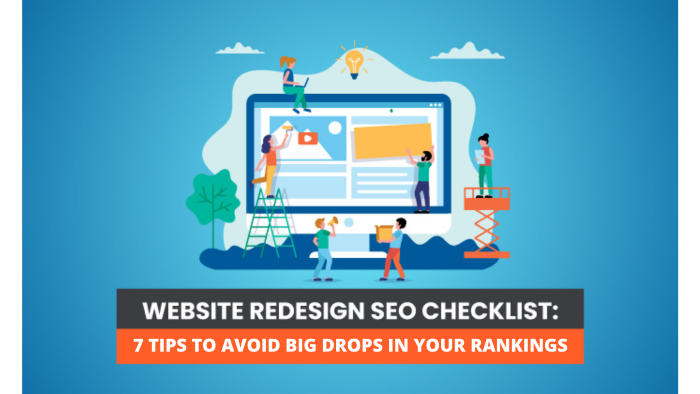
When redesigning your site, it’s important you avoid the pitfalls that can severely hamper your SEO. To help you do this, here’s my website redesign SEO checklist.
What Is a Website Redesign?
A website redesign involves large-scale changes to your website. During a redesign, elements of your code, content, structure, and visuals may change dramatically, giving your site a completely fresh look.
This is a natural—and important—part of a website’s development. As much as 50 percent of consumers believe website design is an important part of a company’s brand.
Even if you had the greatest website in the world back in 2001, it would be looking very out of place today if you didn’t make any large changes to it. Here’s what an Amazon web page looked like back in 2001.

Design best practices change, technology changes and your target audience’s expectations change; your website needs to change to keep up.
Accessibility plays a big part as well. When visiting a site for the first time, 38 percent of people will look at the page’s layout or navigational links.
Sometimes these will mean making smaller changes as part of a website refresh, but occasionally, you’ll need to make more large-scale changes in the form of a full-scale website redesign. Either way, you need to make sure you are following current best practices so your website redesign SEO isn’t affected.
Benefits of a Website Redesign
Website redesigns aren’t without risk (especially for website redesign SEO), but when done well, they offer significant upside. They can:
- improve SEO and site performance
- simplify the user experience
- focus your content strategy
- give your site a facelift
- offer faster load speeds
- provide up to date security
The most obvious benefit is since your website serves as a modern-day shop front, you want to make it attractive.
If a physical store has a broken sign, poor lighting, and a dingy interior, it’s going to struggle to appeal to people. It’s the same for a website; if it looks tired and out of date, your visitors are going to wonder if your business is tiring and out of date as well.
A website redesign is about more than just a facelift.
It also gives you an opportunity to change the fundamental structure of your website and make it easier for visitors to navigate. You want to start with the right approach since even doing a simple redesign with basic features can take an average of two months to complete.
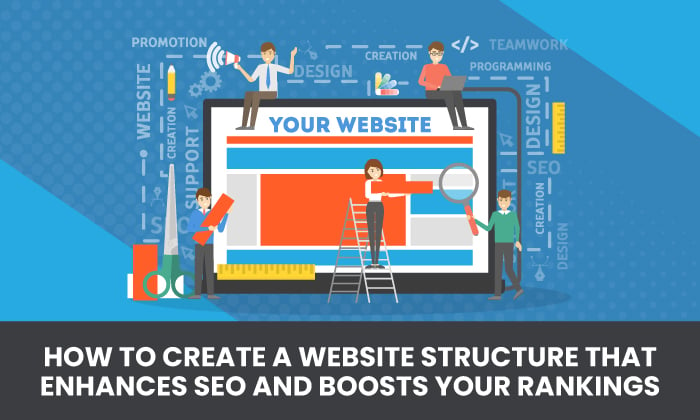
Businesses change over time, and as their websites evolve and grow naturally, the structure of the website can become messy. You add new content categories, move things around on your nav bar, switch parent and child pages, and so on.
A simple rule when it comes to design and UX is that complicated design is rarely good. You want to make it as simple as possible for your visitors (and bots) to navigate your site and find what they’re looking for. A website redesign is a great opportunity to do this.
This is an ideal time to evaluate your site, decide on your goals, and create a redesign strategy that can help you achieve them.
When Are Website Redesigns Necessary?
According to a 2020 survey, here are the top reasons for a website redesign:
low conversion rates (80.8 percent)high bounce rates (65 percent)needs better UX (61 percent)not responsive on all devices (53.8 percent)outdated website (38.5 percent)not SEO-friendly (23.1 percent)
It can be tricky to know when a website redesign is necessary. Chances are, you’re investing a good chunk of money in your redesign, so you want to get the timing right.
The thing to remember is user experience is absolutely essential in digital marketing. It’s going to show in almost every metric and, ultimately, it’s going to have an impact on your bottom line.
The metric closest to most website owners’ hearts is conversion rate. This can be a big sign that it’s time for a website redesign.

Conversion rates fluctuate, but if yours is in a downward spiral, then it might be time to consider a website redesign. They are also different depending on your industry.
For example, if your website is part of the Real Estate or Home Improvement industries, your conversion rates will be around 7 percent. However, if you are part of the Media & Entertainment industry, it might be closer to 18 percent.
One of the best ways to know if it’s time to make changes to your website is to use it from the point of view of your visitors. Imagine you’re visiting your site for the very first time and ask yourself these simple questions:
- Does the branding seem on-point?
- Do pages load quickly?
- Is your site laid out in a logical way that’s easy to navigate?
- Are your pages optimized for mobile?
- Is it difficult to find the information you’re looking for?
- Is your customer journey streamlined enough?
Compare your website to your competitors and see how you stack up. If you find your site is good in certain areas but missing a few details in others, a website refresh might be the answer. If there are lots of things holding you back on the other hand, then it’s probably time for a full website redesign.
Website Redesign SEO Considerations Before Getting Started
The top reason visitors leave a website is due to slow loading times—88.6 percent of survey respondents in a 2020 survey affirmed this. Page speed, directly and indirectly, affects SEO.
This is just one reason to be vigilant about multiple factors that can affect website redesign SEO— planning a redesign isn’t something that should be taken lightly. The rewards are great when things go right, but can be a nightmare if things do go wrong.
The first step is to consider your goals.
What do you want out of your website redesign? What realistic targets can you set?
To set the right goals, you’ve got to have some benchmarks for your current website performance. Make use of your analytics and come up with SMART goals.

Once you’ve come up with your goals, then you can begin thinking about a timeline. The important part here is to be realistic. As you’ll see in the website redesign SEO checklist, there are a lot of steps to consider, so make sure you give yourself enough time to do a great job.
Then you’ll need to put together the right team to carry out your vision. You’ll need talented designers, developers, and content managers to ensure things run smoothly, but don’t underestimate one key element: communication.
Your team needs to be working together and communication is extremely important.
Website Redesign SEO Checklist
This website redesign SEO checklist will help you stay organized throughout the entire process and make sure you don’t miss anything important.
1. Audit Your Existing Content
Content powers many websites’ organic presence. Eighty-two percent of marketers actively use content marketing, and many successful businesses are built off of it.
A website redesign SEO process has the potential to take your content efforts to the next level, but first, you’ve got to have a good picture of where it’s at.
First, use a tool like Screaming Frog to pull data on all URLs included in your website.
Next, use your analytics and Ubersuggest to perform a complete content audit to determine your most important pages, see which pages are irrelevant or not needed anymore, and which should be redirected or combined with other pages.
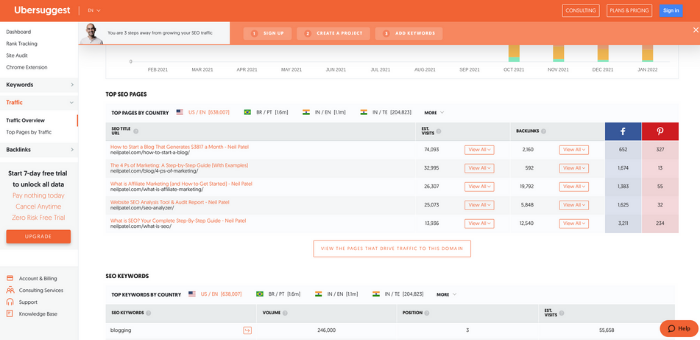
Follow these steps and you should have a clear idea of which pages (and keywords) are most important. Look at your traffic stats, rankings, and conversion goals to see where other improvements can be made.
2. Update Information Architecture
Over 60 percent of users report leaving a website due to bad navigation. Although website navigation and information architecture (IA) are different, your IA should inform how your site navigation is structured.
Information architecture is about how you organize information in your sitemap. Navigation is how you organize your website.

As mentioned earlier, 38 percent of people will look at a site’s layout and navigational links on their first visit.
Let’s use this example post: “How to Scale Mt Everest.”
If people have to find it by navigating through a tips page, then climbing strategies, then Asian peaks, before finally clicking Mt Everest, it’s going to be nearly impossible to find.

Wouldn’t it be a lot easier if the process could simply be Peaks > Mt Everest > How to Scale Mt Everest?
How you organize information all depends on what your website is about, why people come to your site, and what information is most valuable.
To update your IA:
- Start by creating a map of your current structure.
- Do competitor analysis to see how your competition organizes their websites.
- Use a tool like Hotjar to see where users click and how they interact with your site.
- Using note cards or post-its, write down the main categories for your site.
- Next, write your subheadings based on the data you’ve collected.
- Write down the URLs for pages you keep, and organize them under the subheadings.
- Create a new sitemap based on what you created.
3. Carefully Map URL Redirects
In a Semrush study that analyzed 150,000 websites, 42.5 percent of the websites considered had broken internal links.
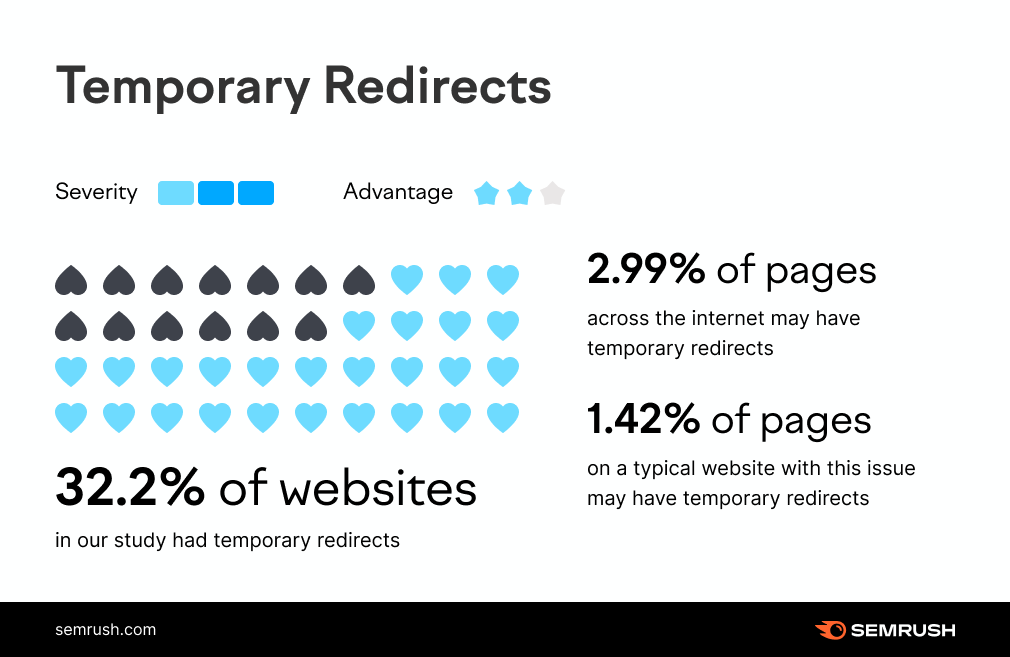
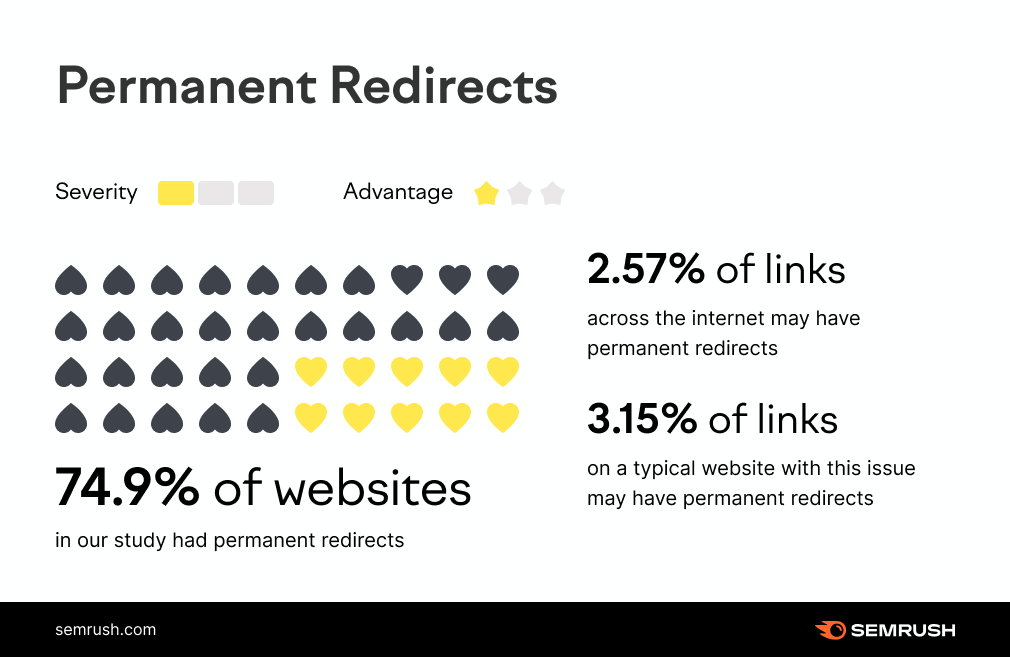
In the beginning, I mentioned how website redesign SEO processes aren’t without risk. The greatest of those risks is the potential of losing a lot of the hard work you put into building your organic profile.
A website redesign is going to change the structure of your entire site. Some pages will get moved, some will even get deleted.
The thing is, small changes can make a big difference in SEO land. As much as 60 percent of marketers say SEO and content marketing is their biggest source of leads.
Let’s go back to our amazing article on “How to Scale Mount Everest” that’s bringing in lots of organic traffic.
The problem is you posted it in a category that’s not very accurate, and you gave it a messy URL structure. Naturally, you want to fix this, so you change the category and URL.
You haven’t even touched the content, but this change can have huge consequences. This is because there are links out there already pointing back to the old URL, so when people (and bots) follow them, they end up at a blank page.
Unless you use URL redirects, you’re not only losing your referral traffic, but you also lose the page and domain authority those backlinks have already built up.
Essentially, your well-established and successful article has to start from scratch all over again.
Redirects can get very messy with a large website, so it’s important to carefully map them.
How to map URL redirects:
- Create a list of all URLs you are keeping as well as those you will no longer be using.
- Create another list of content you plan to keep that will be under a new URL.
- Match each old URL with its new URL. For the URLs you are getting rid of, match each to new content that covers a similar topic. Give the list of new content mapping scenarios to developers to implement the redirects.
4. Optimize Content You’re Keeping
After doing your content audit, you should have a good idea of what content you plan to keep. If you’ve put the time and effort into your audit, you will likely have flagged some areas of improvement for some of your best pages.
A website redesign is a perfect opportunity to refresh old content and give it a new lease of life. This process alone can increase organic traffic by as much as 106 percent.
Content decay is real. New information comes to light, competitors invest in their content, and suddenly your best pages have been pushed down the rankings.
Click through rates for the top organic rankings drop off extremely quickly:
- 1st result: 34.2 percent
- 2nd result: 17.1 percent
- 3rd result: 11.4 percent
- 4th result: 8.1 percent
- 5th result: 7.4 percent
Dropping from the top rank can immediately cut your organic traffic in half, so it’s important to optimize your existing pages.
Your website redesign SEO should help with the UX side of things, but what else can you do to improve content rankings again?
- Use Google Search Console or an SEO tool like Ubersuggest to see how your content is performing.
- See what keywords your top-performing content pieces are ranking for. To improve those rankings, even more, add target keywords to headers, increase keyword density (without stuffing) throughout the post, and use keywords in image alt text and file names.
- Dig into content that isn’t performing well. Make improvements by rewriting it or updating it with recent links and studies as well as data points, expert interviews, and visuals or videos.
5. Optimize Page Speed
You can’t underestimate the importance of page speed. Everyone knows the feeling of waiting forever for a page to load, and you know what users do when that happens; they leave and look for information elsewhere.
Technology has made people expect things much faster these days, and interacting with a website is no different. 25 percent of people leave a website if the page takes more than four seconds to load, and a one-second delay results in a 16 percent drop in customer satisfaction.
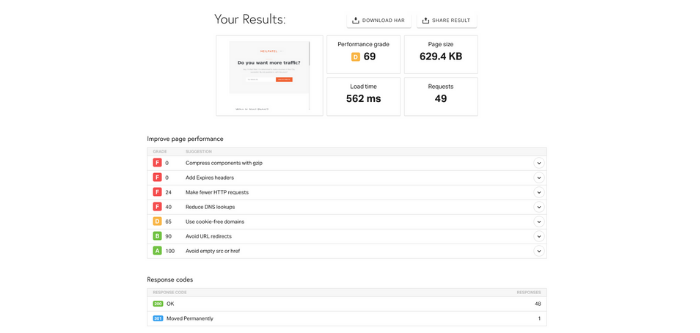
Websites tend to become bloated over time. A website redesign SEO process lets you take the opportunity to optimize page speed by addressing the bloat.
First, you want to make sure images are optimized to the correct size and format. Make embedded videos load properly and, if they don’t, use tools to decrease the file size or shorten the videos.
Next, reduce the number of HTTP requests. You should also minify your CSS and JavaScript, and clean up your HTML.
This should be something you consider from the very start of your redesign, and you need to stress it as a priority for your developer.
6. Update Your XML Sitemap
Your XML sitemap is like your website blueprint. Google and other search engines use it to understand the purpose of your content and it’s crucial for good website redesign SEO.
You can either do this manually by adding every URL in your updated site to the map or use an SEO plugin like Yoast or AIOSEO to generate one automatically.
This is a simple but important step. If Google is looking at an incorrect XML sitemap, their crawlers may ignore your site entirely (as confirmed by Google’s John Mueller).
7. Test Your Site After Redesign Is Complete
Across the internet, 0.27 percent of internal links are broken and 1.37 percent of external links are broken. Broken links are just one of the many issues you need to consider when testing your website after a redesign.
Redesigning an entire website is a huge undertaking so every detail isn’t going to come out perfect straight away.
If you launch your new site immediately without testing it first, these imperfections can have big consequences.
It’s tempting to get the ball rolling and start with your new website as quickly as possible, but you’ve got to put time into testing. Review all of the changes on your test site (get your friends and family on board as well) and go through the website with a fine-tooth comb.
You can create specific tasks for everyone involved in user testing your site.
- test CTAstest site navigation (it should make sense and all tabs/navigation links should be clickable)look at side navigation links
- Review forms, pop-ups, and exit overlays if you use them
- audit internal and external links
- pay close attention to interactive content and purchasing pages
- have people text on desktop, tablets, and mobile devices (Android and iOS)
Add any errors you find to a spreadsheet and go through them with your developer.
Again, it’s about exploring your website through the eyes of your target audience. If you do this well, then you’ll fix a lot of errors before they reach the end-user.
Website Redesign SEO Frequently Asked Questions
How much do website redesigns affect SEO?
Website redesigns can have a big impact on SEO. When done well, the improved UX can boost rankings, but if the redirects aren’t carefully mapped, it can lower your authority and result in your website losing a lot of organic traffic.
How much do website redesigns for SEO cost?
The cost of a website redesign will depend on the complexity of your website. Basic redesigns can start at around $15,000 but more complicated ones can cost upwards of $75,000.
What are the most common SEO errors in website redesigns?
Some of the most common SEO errors with website redesigns are forgetting to redirect URLs and not keeping your most successful content.
What SEO tools do I need for website redesigns?
SEO tools are useful for website redesigns because they allow you to evaluate your performance. Your Google Analytics is essential, but ranking checkers like Ubersuggest can also be very useful.
Conclusion: Website Redesign SEO
There comes a time when you need to think about website redesign SEO. This is an important moment for your business, and it needs to be handled with care.
A website redesign carries lots of risks when it comes to SEO, but at the same time, it can offer lots of rewards. To maximize those rewards and minimize the risks you need a clearly defined strategy and that is where this website redesign SEO checklist can help.
That covers the SEO side, but I’ve also got some more tips on how to safely carry out a website redesign, so check them out.
Are you planning a website redesign? Let me know in the comments below!
Source: neilpatel.com

15 Conversion Rate Optimization Tips to Boost Your Rankings
Conversion rate optimization, or CRO, is the process of optimizing your website to increase the completion of a specific action. In most cases, the desired action is an actual sale, but not always.
Desired actions could include demo sign-ups, downloading an asset from your website, trying out a new tool, or signing up for your newsletter. If it helps you grow your business, it’s a conversion—and it can be optimized.
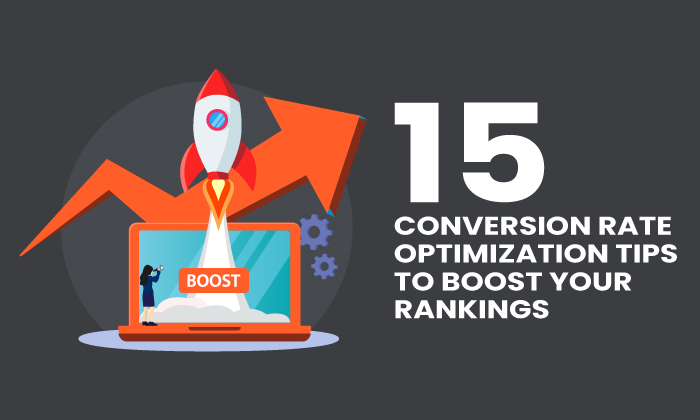
The beauty of these conversion rate optimization tips is they work regardless of your intended conversion method.
CRO Tip 1: Add Site Search to Your Website
Up to 30 percent of visitors will use a search box if it’s offered. Unfortunately, nearly 84 percent of companies don’t optimize their on-site search to meet user expectations.
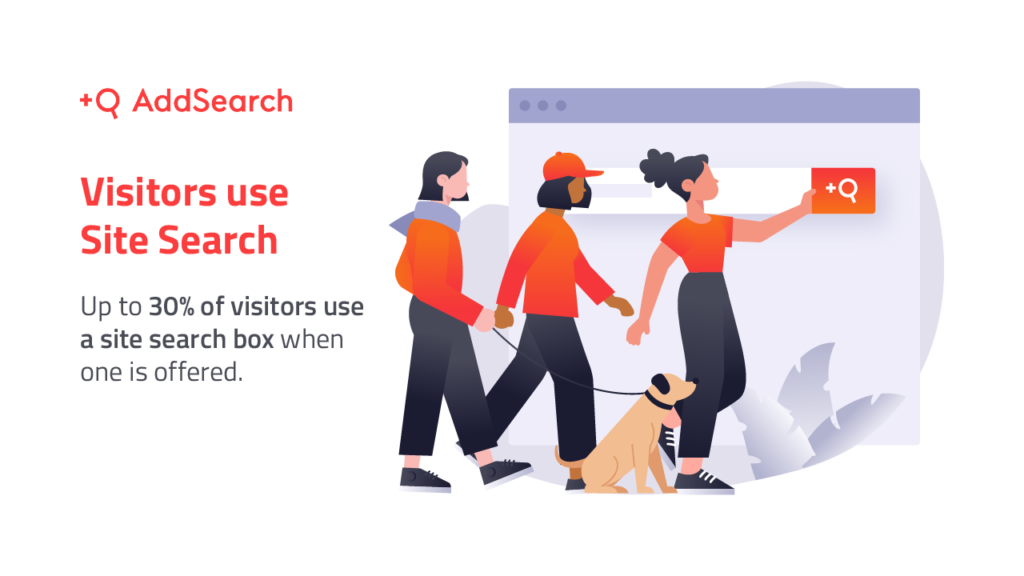
This means if your website doesn’t already include a site search, it’s time to consider adding it.
The main benefit of site search is user experience. However, data from search results can provide valuable insights into user behavior by showing you exactly what they’re searching for.
This information can help you tailor content to meet those needs or add new pages to your site to fill any gaps.
You may even be able to identify users in different parts of the funnel based on the search terms they use. This information can help you to narrow your customer’s most common questions and pain points, helping you tailor the website experience to their needs.
If you use WordPress, you can add a site search using a widget. If you use Webflow, they’ll actually let you customize it. Wix and Squarespace make it easy to add site search as well.
CRO Tip 2: Ensure Forms Are Easy to Fill Out
The average form abandonment rate is 68 percent—which means most people won’t finish filling out your form.
Website forms serve many purposes, including newsletter signup, lead magnet acquisition, and product/service inquiry.
Keep in mind: the easier a form is to fill out, the higher your expected conversion rates.
According to Hubspot research, a typical form has about 5 fields on average—and forms that are A/B tested get about 10 percent higher conversion rates.
In my experience, simple is better.
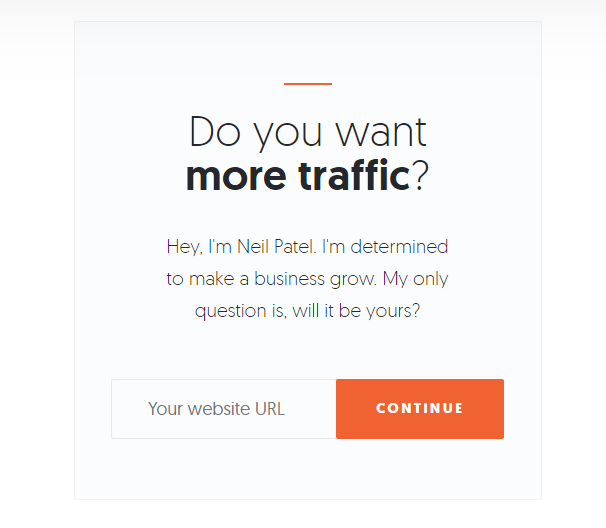
This is an example of a simple form I use on my blog. All the user needs to do is enter their website’s URL and the action is complete. It doesn’t get much simpler than that.
A few ways to ensure your forms are easy to fill out:
- make form names clear use proper HTML formatting
- use relevant sample placeholder text (I used “Your website URL” in the example above)
- have a distinct and easy-to-local submission button
CRO Tip 3: Improve your CTAs
If you want to improve conversions, CTAs are low-hanging fruit. The average CTA click-through rate is just 4.23 percent, but many factors can impact what helps your CTA convert.
For example, if you include more personalization in your CTAs, conversion rates can improve more than three times as much.

That’s why you should continually test CTAs to see what works and what needs improvement. You’d be surprised at how quickly user preference can change!
Start by testing these CTA elements:
- copy
- colors placement
- button shape
- button size page placement
Consider testing different types of CTAs as well. Here’s how CTA types convert, according to a study by Vye Agency:
- button CTAs have an average CTR of 5.31 percent
- text CTAs have an average CTR of 2.06 percent
- designed CTAs have an average CTR of 3.53 percent
When it comes to branding, consistency is key. However, using colors outside of your branding palette for CTAs is worth trying. Colors within your palette might blend in too well with the rest of your site, making them easy for website visitors to overlook.
CRO Tip 4: Run User Testing
Poor usability can kill your business. 70 percent of online businesses fail because of poor usability.
If you’re in e-commerce, your conversion rates could increase by 35 percent by just improving the design and flow of the user checkout process.
User testing is the way to get valuable data that can help you get more conversions across your website. So it’s important to get this process started as quickly as possible.
One of the most common ways to run UX testing is with heat maps, which show how users navigate your site and what interactive elements they’re clicking on.
You’ll see if they’re looking at your links, navigation bar tabs, CTAs, and so on. Some heat maps even incorporate eye-tracking software to show where your users look first.
There are several heat mapping tools on the market, but my favorites are Crazy Egg and Hotjar. If you decide to use Hotjar, the process for setting them up is very simple and straightforward.
CRO Tip 5: Add More (Better) Social Proof
More consumers than ever read social proof. In fact, 77 percent of users say they always or regularly read online reviews before buying.
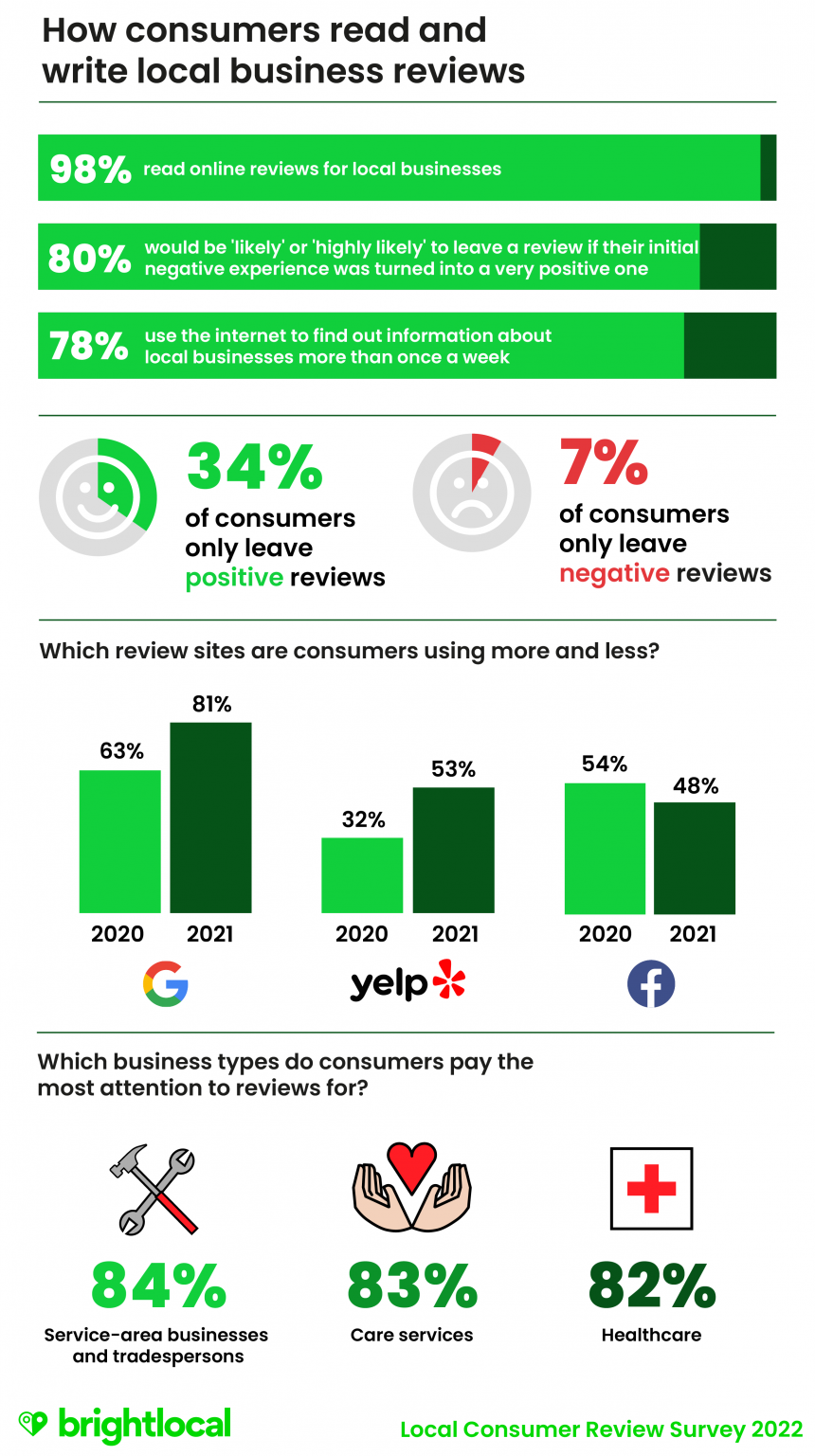
You want to leverage customer loyalty as often as you can. Why? It’s free marketing and brand exposure. Even better, reviews can drive revenue.
According to Womply, businesses with more than average reviews across earn 54 percent more in annual revenue
It is also easy to create.
Social proof is a simple and great way to leverage user-generated content for your brand. This can include positive reviews and ratings, creative social media posts about your brand shared by customers and influencers, user-submitted content like photography, and more.
The benefit of adding more social proof to your website is it shows other users that other people trust you. Trust and credibility play a big factor in getting more conversions.
To add more social proof, try:
- Send a follow-up email asking for reviews.
- Host a contest with a branded hashtag on social media.
- Include a card with a branded hashtag when shipping physical products.
If you want to do it on a larger scale, consider automated tools like HotFomo and OptinMonster.
CRO Tip 6: Add Chatbots or Live Chat
If you have a question, wouldn’t you rather get the answer fast? That’s the idea behind chatbots. No matter how great your customer service is, sometimes call queues to get long.
The good news? Users like chatbots. The average satisfaction rate of chatbots is 87.58 percent. They can also reduce customer service costs. One study predicts chatbots will save businesses $8 billion in customer service costs by 2022.
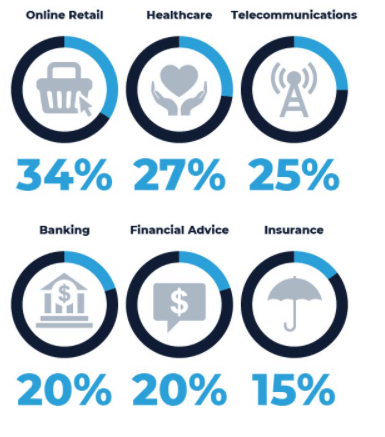
These tools help your brand build an instant connection with customers, making them more likely to purchase your product or service. Here are a few ways to leverage chatbots;
- answer FAQ
- qualify leads
- suggest related products
- troubleshoot common issues
- Share information about new products
- increase your email list
With so many chatbot options available, it can be challenging to find the right one. I recommend focusing on native channel integrations to narrow your search.
If you want an app with widespread integration options, consider Landbot, which offers chat features through the web, WhatsApp, Facebook Messenger, and API.
Perhaps you just need to integrate with Facebook Messenger? In that case, Chatfuel is an affordable solution.
Make sure that whatever chatbot you choose aligns with your business goals.
CRO Tip 7: Review Customer Persona and Adjust Your Messaging
A customer persona is a fictional snapshot of your ideal customer. Personas are commonly used by marketing agencies and businesses to give their target audience a human face. They can help drive leads, increase conversions, and shorten the sales cycle.
According to MarTech, creating a persona can increase email CTR by 14 percent—and conversion rates by 10 percent.

The gap between who you think your ideal customer is and your actual customers may be more significant than you think.
For example, if your personas are businesswomen in their early 30s but your customer base is primarily homemakers in their 50s, there’s going to be a massive disconnect in how you approach your target audience.
Here are six steps you can take to make sure you are targeting the right customer personas:
- Make a list of your highest value customers.
- Use a customer persona template to create a new persona.
- Start adding details from your highest value customers.
- Start with demographics like location, age, budget, education, etc.
- What channels do your highest value customers use to find you?
- Add that to your persona as “methods of communication.” Look at the content they consume—what does that tell you about their motivations?
- Add those to your template.
- Repeat the process for every product or service you offer.
It’s important to realign your customer personas with your messaging, sometimes as frequently as every two or three months. In some cases, this could mean tailoring your brand approach altogether to connect with the new target audiences working.
CRO Tip 8: Use Targeted Lead Magnets
Lead magnets are a free resource (like an ebook or guide) given away in exchange for user data. The most common lead magnets are PDFs or videos, but there are plenty of media types to use.

The best part? They work.
Fifty percent of marketers say lead magnets increase their conversion rates.
The more targeted your lead magnets, the more effective they are likely to be. The key is to get creative with your targeting.
You could even consider creating some more interactive lead magnets like quizzes or online calculators. According to LeadQuizzes, the average quiz has a lead capture rate of 31.6 percent.
The way you target your magnet will depend on your product or service. For example, if you serve a geographical area, it may make sense to target leads based on location. Other websites might target leads based on industry or how they got to the site.
Here are a few other targeting options:
- time on page
- type of content
- whether they’ve purchased before
- industry
- customer persona
- location
- time period (for example, a pop-up for an upcoming event)
Not sure how to add targeting to your lead magnet strategy? These lead magnet tools can help.
Whatever type of lead magnet you decide to create, be sure it aligns closely with your intended customer. Since the goal of lead magnets is to collect user data, you want to make sure the offer is valuable to your intended audience as well as your business.
CRO Tip 9: Use Pop-Ups Carefully
Pop-ups have an average conversion rate of 3.09 percent, which makes them ripe for CRO.
I have a love/hate relationship with pop-ups because they walk such a fine line between being beneficial (for you and your customer) and incredibly annoying. However, when done right, pop-ups can be an invaluable conversion tool.
In fact, Marketing 112 increased its conversion rates by 62 percent by adding a pop-up to its website.
First and foremost, your pop-ups should respect universal UX rules. These include fast load times, visible exit options (like the example from Wishpond below), and platform-appropriate size.
There should also be limits as to how often users see the pop-up. For example, a user who bypasses the pop-up once shouldn’t be bombarded with it on each page of your site they navigate.
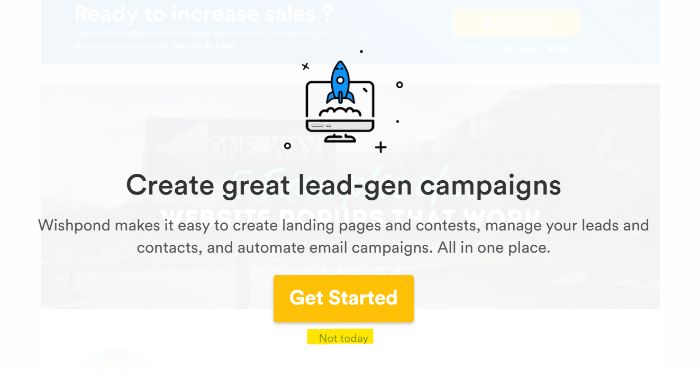
When it comes to conversions, keep the messaging short with minimal effort to take the desired action.
You can also implement A/B testing to see how users interact with different versions of the pop-up. This is important for optimizing conversion rates across the board.
CRO Tip 10: Check Your Site Speed
If your site loads slowly, all of the conversion rate optimization tips in the world won’t make a difference. In fact, website conversion rates drop by 4.2 percent for each additional second your site takes to load.
Even more surprising? More than 80 percent of sites don’t meet acceptable speeds.
Fortunately, there are plenty of free sites and tools that let you test your site speed and troubleshoot common issues.
PageSpeed Insights and Pingdom are two of the industry leaders in this domain. These tools have been around for years and offer the most in-depth testing and troubleshooting. They first look at contentful paint, time to interact, and total blocking time to calculate your overall score.
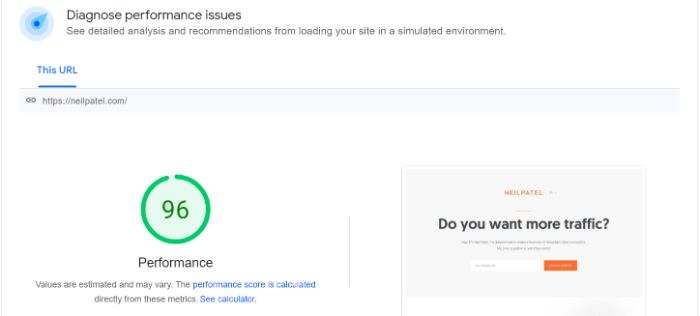
What are some of the most common issues that slow down site speed?
- render-blocking JavaScript
- poorly optimized CSS
- large media files
- bulky code
While some of these may require a database engineer or developer to resolve, you can usually start to tackle some issues (like large media files) on your own.
CRO Tip 11: Recover Lost Sales by Following up on Abandoned Carts
According to the Baymard Institute, the average cart abandonment rate is 69.82 percent. That rate is even higher on mobile where the average shopping cart abandonment rate is 85.65%.

Recovering just a fraction of those missed sales could do wonders for your conversion rate.
If the main benefit of CRO is converting users already on your site, then abandoned cart users are the cream of the crop. They actively started the transaction but didn’t complete the purchase.
There may be some obvious reasons for this, such as a discount code no longer being valid or high shipping rates. Whatever the reason, you should always aim to recover the lost sales using (almost) any means necessary.
In fact, if e-commerce sites just fixed checkout usability issues in their process, they could increase conversion rates by 35.26 percent. This translates into more than $200 billion in recovered sales from the e-commerce industry alone.
Here are some other ways you can recover abandoned carts:
- automated email flow
- son-site push notifications
- retargeting ads
- personal outreach
- automated social outreach
You don’t want to harass potential customers who have abandoned carts, but you do want them to feel wanted. Sending just one email could help you recover up to 29.9 percent of these sales.
You may want to play with your outreach timelines to find the right approach for your customer base.
CRO Tip 12: Make Sure Landing Pages Match Your Messaging
The average landing page converts just 2.35 percent of the time across all industries. If you want to be a top performer in your sector, you should be aiming for conversion rates above 10 percent.
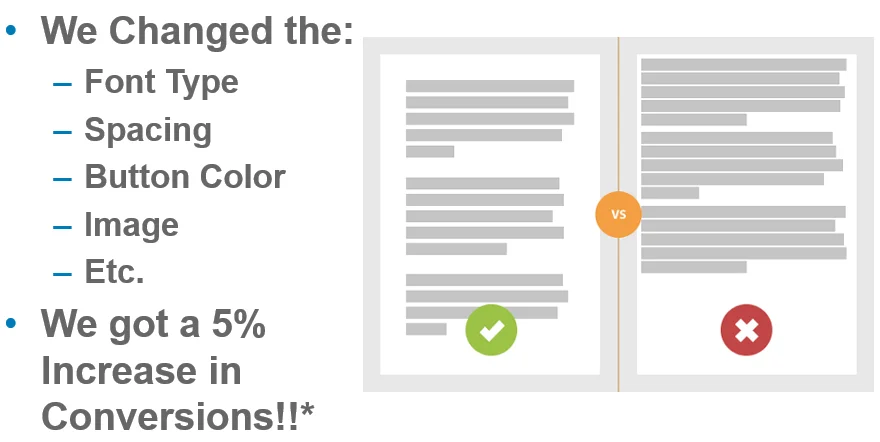
So, how do you increase your landing page conversion rate?
One way is to ensure the messaging on your landing page matches the ad or copy that brought them there in the first place. This creates a more cohesive experience, showing users that your page is the right fit for what they want. It will also help improve your PPC quality score.
Here’s how to match your messaging:
- use similar language in your landing page and ad (especially the main keywords)
- keep branding consistent (include your logo and use brand colors)
- use a clear CTA on both your ad and landing page
Just imagine how off-putting two distinct messaging styles can be to the user. Imagine if you agreed to a job interview for a tech company and found out it was a restaurant when you arrived. It would feel like a bait and switch, right?
While a difference in messaging between an ad and landing page isn’t quite as off-putting, it’s close. The differences can be jarring and steer users away.
When creating your landing pages and ad copy, make sure you have a clear focus in mind. This would start with your keyword research when you select the target phrase for the page. You can include some secondary keywords on the landing page as well if you plan to use them in your ad copy.
CRO Tip 13: Target High Intent Users
High intent users are very close to making a buying decision. According to a report by the CMO Council, 87 percent of B2B buyers say that online content has a major or moderate impact on the vendor they choose.
That means there’s an extremely high opportunity to improve your content to convert these users.
How can you target high-intent users?
As previously mentioned, looking at the internal search terms users interact with on your site is one way to get an idea of content that works. Someone at the bottom of the funnel might be trying to distinguish between different options, so they’ll be looking more closely at shipping timeframes and return policies.
Here are a few other strategies:

- Add high-intent keywords to your ads and landing pages.
- Use the information from your internal search to gauge what keywords are and how your customer base interacts with them.
- Build content that targets customer pain points.
- You can often identify these pain points with SERP analysis of high-intent keywords.
- Pay attention to intent data.
- Contact users who visit your pricing page, return to your site several times, or book a demo but don’t follow up.
High intent users are ready to convert, so don’t leave them hanging.
CRO Tip 14: Optimize Your Content
If your content isn’t performing well, it’s time to re-evaluate and optimize it. The first thing to check is title tags.
According to Backlinko’s research of more than 11 million Google search results, sites that include the main keyword in their title tag are far more likely to rank higher.
Content optimization looks at a number of factors including:
- Make sure the keyword is used several times content length variance (add or remove content)
- check image optimization, such as size and alt tags
- add stats and new research check meta and SEO titles
- add keywords to more headings
- add a frequently asked questions section
- make sure you aren’t cannibalizing traffic from other content on your site
For time and efficiency, you don’t have to do all of the above. Instead, research the top 10 results on Google for your target keyword and see how they are structuring their content.
Their approach is clearly having an impact on their ranking and can provide a path for you to improve your search engine rankings.
CRO Tip 15: Before You Make Changes, See What Works Now
It’s easy to see all of the things that need to be improved, but what about the things that are working?
There are likely some areas of your website that are already working. For those, look for patterns in what the data is telling you, determine what the essential parts that led to the results might be, and come up with an approach to replicate this across your site.
If you aren’t sure how to approach this yourself, you can hire a professional to audit conversions across your website and highlight what is working well. This process alone could uncover a lot of great things you’ve been doing but probably don’t realize.
The last thing you want to do is a major content overhaul that loses conversions from pages or strategies that are already working.
Frequently Asked Questions About Conversion Rate Optimization Tips
What is conversion rate optimization?
Conversion rate optimization (CRO) is the process of increasing the conversion percentage for a website or mobile application. The aim is to increase the number of people taking the desired action in relation to the number of visits by improving customer experience and testing interactive elements.
What is the most effective CRO strategy?
There’s no one way to approach conversion rate optimization. However, a good CRO strategy will focus on user experience optimization, customer journey analysis, and website performance.
Is CRO different for ecommerce?
The benefits of CRO are the same whether they’re being implemented for an ecommerce site or not. However, the processes may differ slightly. When it comes to ecommerce, the conversion funnel has a larger part to play than it might on a non-ecommerce site.
How can conversion optimization affect your return on investment?
In simplest terms, CRO aims to make the most of the site traffic you already have. By increasing the conversion of your existing traffic, you have the potential to lower your customer acquisition costs.
Conclusion: Conversion Rate Optimization Tips
When you consider the fact that customer acquisition is more than half of the battle, it makes sense to focus heavily on conversion rate optimization.
After all, converting more of your existing website traffic could drastically reduce customer acquisition costs.
You’ll notice most CRO tips focus on improving the user experience and enhancing the customer journey. That’s because they tend to have the most significant impact. However, you don’t have to implement all of these CRO strategies immediately. Think about which will have the most significant impact and test those first.
Which of the CRO tips above do you think will have the most impact on your conversion rate?
Source: neilpatel.com

Do Links from Guest Posts Even Work? Here’s What We Learned from Analyzing 1,091 Sites That Accept Guest Posts.
It’s frowned upon to build links through guest posts.
If you do, they should be nofollowed and ideally you should be guest posting for brand awareness and referral traffic.
Even though that’s what I follow, it doesn’t mean others do.
Plus, I get hundreds of emails a day asking me if I accept guest posts, hence I know it’s still a popular link building method (although I ignore all those emails).
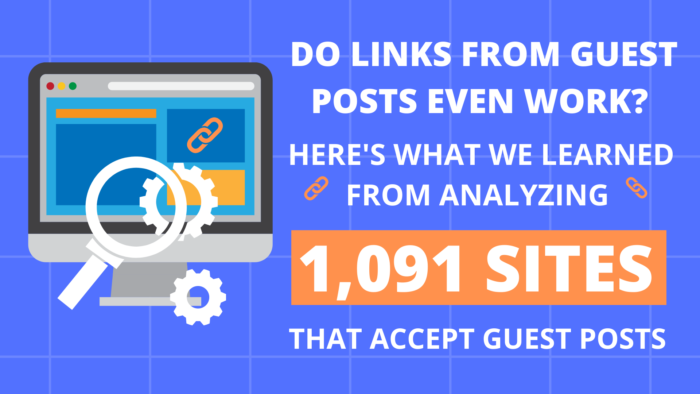
What Kind of Sites Did We Analyze?
First off, not all blogs accept guest posts. So, if a blog didn’t accept a guest post, we clearly didn’t include it in our study.
Second, we looked at sites that clearly labeled content as a guest post or as a post written by a guest author or guest contributor.
Third, we looked at sites that used dofollow links in the guest posts (even though they should have been nofollowed) to see if they had an impact on rankings.
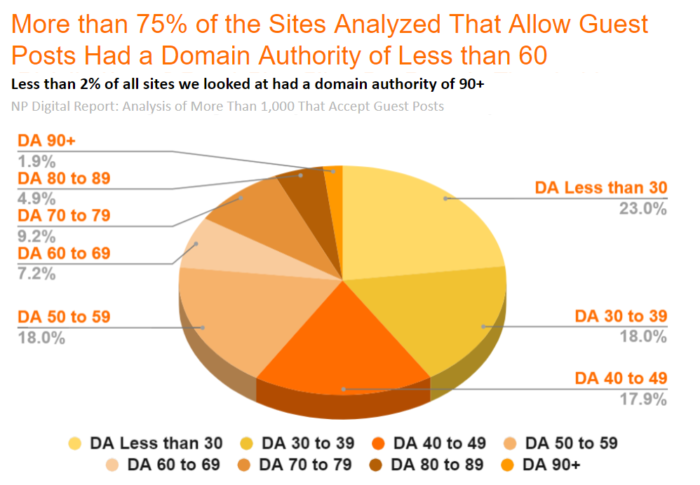
As you can see from the graph above, we looked at sites across different domain authority levels. We wanted to see what impact it had on whether a guest post received traction or not.
We also looked at sites with varied traffic ranges to see where posts might perform best.
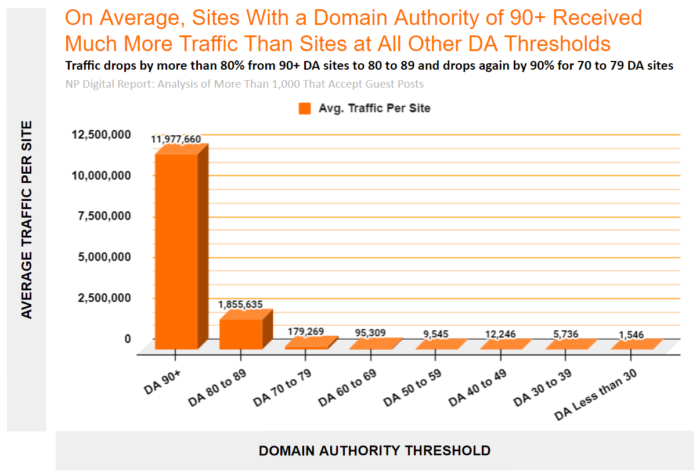
As you can see, targeting sites with a domain authority above 90 will likely lead to more traffic. At the same time, those are also the sites that will be hardest to get links from.
So, What Did We Learn?
The short answer: guest posts links kind of work and kind of don’t.

I know that isn’t a clear answer, but it is if you read the rest of the post. Because there are certain types of guest post links that work and there are others that don’t.
Here are some more insights…
Too Many External Links Is Bad
Some guest posting sites link out a lot.
Some don’t link out too much.
Although you shouldn’t be focusing on how many times you do or don’t link out, you should be focusing on providing the best user experience to your audience. If that means including a relevant link to another site in your article, by all means link out.
If it doesn’t make sense, then you shouldn’t.
Look at this chart.
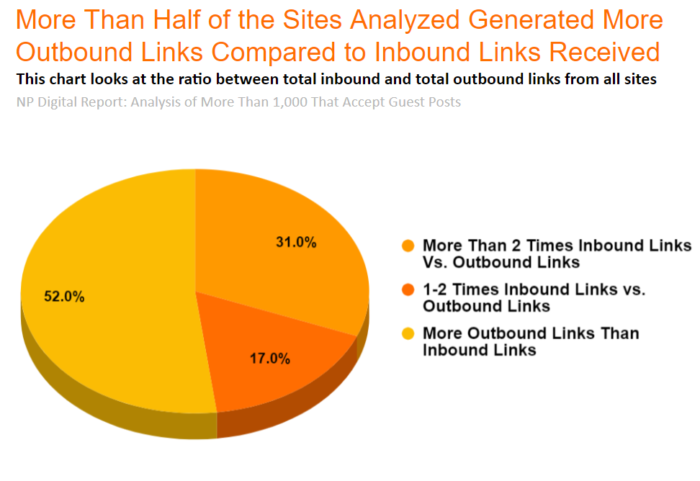
Now, it’s hard to know for sure if a link received from a guest blog site with more outbound links than inbound links is effective since websites don’t just have 1 backlink. Most websites can have hundreds and, in some cases, millions of them.
Just look at my site NeilPatel.com. Sadly some spammy websites link to me (scrapper sites) and some high authority websites link to me. It’s hard to know for sure what the impact a spammy site link has on my rankings compared to the ones received from high domain authority sites.
Instead, what we could do is look at the number of keywords a guest posting site ranks for. In theory, the more keywords a site ranks for, the better they are since they are liked by Google. I would think that a link from them would be more favorable.
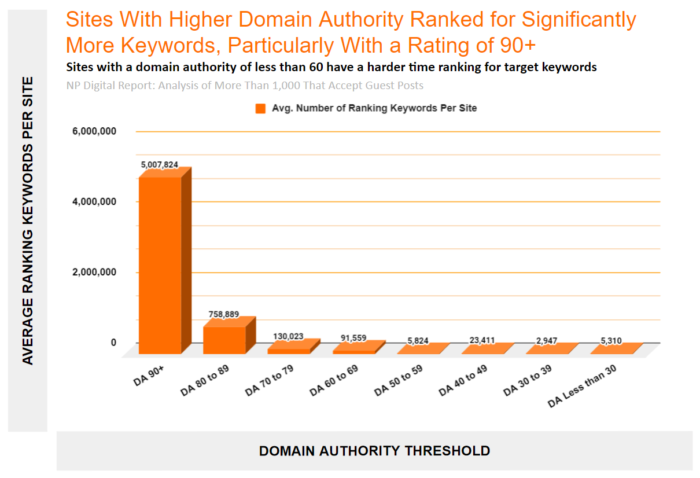
What you’ll notice is, generally speaking, the higher domain authority a site has, the more keywords it ranks for. But we already knew that.
When looking at the domain authority range from 0 to 59, you’ll notice that there isn’t a consistent upward trend. That’s because many of the domains from our analysis in this range tended to be sites that were expired or bought-out and are mainly used for guest posting purposes.
Even more interesting. The guest posting sites that had more external links than inbound links all had a domain authority of less than 60.
From this one insight, someone could infer that you should aim to get links from sites who have more inbound links than external links. As in, sites that have higher domain authority.
You should also avoid guest posting sites that exist for the sole purpose of linking out to other sites. These can be considered spam links.
The Right Links Help
From all of the guest posting sites we analyzed, we found 14 businesses who were exclusively receiving links from some of the sites we looked at. From these 14 businesses, six of them only received links from guest posting sites with a domain authority of less than 60.
In other words, they didn’t have links from any other sites.
So, we dove into their rankings and traffic.
What’s funny is that these six businesses had little to no rankings or traffic.
Let’s look at the number of page 1 Google rankings they had.
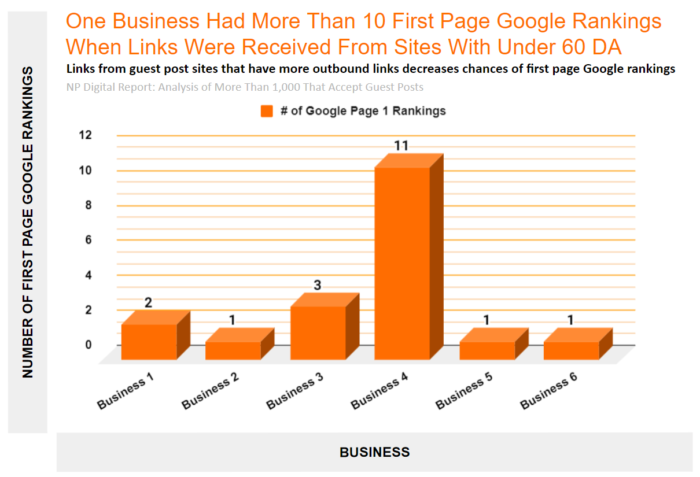
Since these six businesses only received links from spammy guest posting sites, we know that each of those sites had more outbound than inbound links. It’s clear that those sites didn’t really serve a purpose other than for guest posting.
The remaining 8 businesses we looked at also had links from spammy guest posting sites but also received links from more legitimate sources too. As in, guest posting sites that had more inbound links than outbound links.
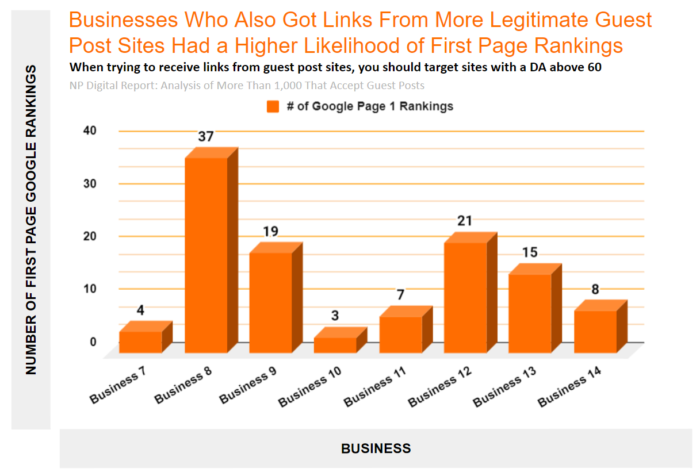
The businesses that built links from the spammy guest posting sites had, on average, 3.16 page 1 rankings on Google. On the other hand, businesses that also built links from the higher quality guest posting sites as well had, on average, 14.25 page 1 rankings on Google.
Keep in mind some industries are easier to rank for than others and some keywords drive less traffic than others, so not all page 1 rankings are created equal.
At the same time, this trend shows that if you target links from higher quality guest post sites, there is a better chance of ranking on the first page.
Conclusion: Do Links From Guest Posts Work?
When I originally said guest posting links can or can’t help it’s because the quality of the link really matters.
When you get links from spammy sites, as in sites whose sole purpose is to link out and don’t get as many links coming in, search engines know this. If this is a practice you have been doing, don’t expect your rankings to go up as much.
On the flip side, if you generate links from higher quality guest post sites, you are going to be much better off.
The goal of this post was to figure out if links from guest posts really help and now we know the answer. However, if you’re going to build links from guest posts than they should be nofollowed and you should be doing it primarily for branding and referral traffic purposes.
Source: neilpatel.com
![Essential SMS and Email Tips: 5 Strategies You Can Implement Now [Free Webinar on February 15th]](https://focusintoprofits.com/wp-content/uploads/2022/02/1644550509.png)
Essential SMS and Email Tips: 5 Strategies You Can Implement Now [Free Webinar on February 15th]
How important are SMS and email for a company’s success in 2022? Very.
78 percent of marketers say email is an important part of a company’s success.
And texting is quickly becoming another way for businesses to succeed. In fact, a 2021 survey found the majority of marketers reported increased revenue from SMS efforts.
If you are looking for new and innovative ways to engage your customers, adapting custom email and SMS strategies might be the solution you need to grow subscriber lists and improve the customer experience.
Join us on Tuesday, February 15th at 8 am PST for a FREE webinar on 5 No-Brainer SMS and Email Marketing Strategies You Should Implement Today!
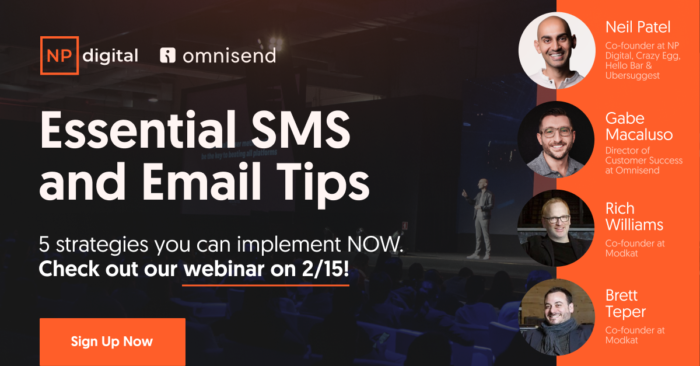
Why Having an SMS and Email Strategy is Important?
By 2024, an estimated 4.5 billion people will use email. When done correctly, email marketing can increase traffic to your website, conversions, and revenue.
What do we mean by “correctly?” We mean following trends, using the latest tools, and relying on data to optimize your emails for opens and conversions.
SMS is also becoming a more effective communication channel. Texts can be used for marketing, to increase revenue, or even to offer quick customer service. In fact, close to 60 percent of consumers check their text messages within 1-5 minutes so they are a great way to get people’s attention.
The click-through rate of SMS is also very high at 19.3 percent, better than email which has a CTR of 4.2 percent, or Facebook ads, which have a 0.05 percent CTR.
You may be wondering how can you get such a high click-through rate with SMS as well, turning those opens into conversions and revenue? Attend our webinar to find out!
Who Will Benefit from Attending the Webinar?
Marketers who want to learn insider tips so they can expand their email and SMS skills.Small business owners who want help launching or improving their email and SMS efforts.Blog writers who want to grow their subscriber list.Anyone who wants to improve their SMS or email click-through and conversion rates.
What Businesses Do Will Benefit from New Email and SMS Tips?
Marketers, small businesses, e-commerce companies, and B2B organizations alike will all benefit from this webinar. Need proof?
- 81 percent of B2B marketers say email is the most important part of their content marketing efforts.
- Eight out of ten B2C customers open their welcome emails.
- And, finally, a survey by Campaign Monitor found 64 percent of small businesses use email to reach their customers.
SMS is becoming just as important for all these business models. How it is used ranges from appointment confirmations to sales promotions, to customer service, and everything in between. In case you need more convincing:
About 33 percent of marketers expect to prioritize mobile loyalty programs over the next year.85 percent of customers say they prefer receiving text messages over a phone call or email.64 percent of consumers think that companies who text value their time and are more progressive.
The email and SMS strategies covered in this webinar can be applied to any business model.
What You’ll Learn in This Webinar
In this webinar, we’ll first go over some of the top email and SMS trends we see coming in 2022. We will explain what each of them means as well as the impact they can have on you and your business.
Next, we’ll provide five detailed email and SMS tips. For each tip, we’ll discuss why we think it could be a game-changer for your business in 2022 and also provide some examples of how each can be used.
Finally, we’ll walk you through some step-by-step processes you can take to implement each tip and start seeing results right away.
By following the tips you will learn in this webinar, you’ll be in a prime position to grow your subscriber list, create a cohesive email and SMS strategy, and get more conversions from each communication you send. We look forward to seeing you on February 15th!
Source: neilpatel.com

How to Identify and Win the Right Influencers to Promote Your B2B Product
Influencer marketing has been on the rise for several years now and it is not showing any signs of slowing down.
People trust people they follow, and it is true in both ecommerce and B2B sectors, although it is a bit different in the latter because marketers and salespeople have larger decision-making units to keep in mind when they sell to businesses.
There’s no impulse shopping in the B2B sector (or at least not as much as in retail), so influencer marketing has to rely on long-term relationships between influencers and their target customers.
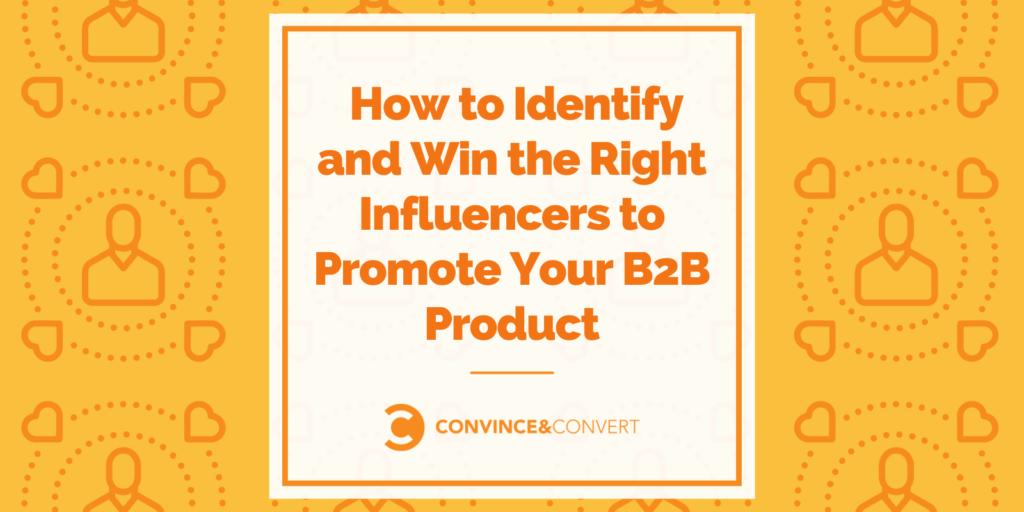
How to Identify and Win the Right Influencers to Promote Your B2B Product
How do you find the right influencers to help you sell your B2B product and how can you turn them into your brand ambassadors?
Step 1: Find the right pitch
Depending on the nature of your B2B product, you are likely to be after several types of influencers, including:
- Your target company’s employees
- Your (inactive and current) competitors’ promoters
- People who post or write on related topics (and may be unaware of solutions yet)
- Companies that sell matching products (possible partners), etc.
Obviously, you cannot use one generic pitch for all of them. “Hi there, I think you will find our product interesting” is not going to get anyone on board.
There are different ways to make your platform appealing for different types of influencers:
- Affiliate marketing (i.e., paying a commission to your influencer for each successful sale)
- Broken link fixing (offering your solution as an update to an article that lists broken or outdated solutions)
- Free tool access (inviting influencers to use your tool for free), etc.
Finding the right tools to make your pitch more appealing will help you onboard more influencers. Try utilizing your sales demos to demonstrate the power of your product.

Walnut is a great tool to include in your pitch as it helps you create reusable and interactive demos which can be easily customized for each pitch type or even influencer:
Here’s a great guide on how to utilize Walnut to target different types of influencers and decision-makers.
Step 2: Focus on the right metrics
In B2B, marketers always know precisely what kind of an audience their product is made for: They know the narrow niche and even the size of the company that would need it.
In this type of laser targeting, finding the right influencers is not about the size of the following or even the amount of content they are producing. They need to find social media users who can influence those few people that can make a buying decision within their target company.
Those social media users may have 10 or 100 followers and even post as rarely as once a month but if their message reaches the right people, they are considered influencers.
Using the right tools to identify these micro-influencers is key.
Linkedin is a great platform to start. It shows you how you are connected to employees of your target company so you can reach out and get introduced to the right people:
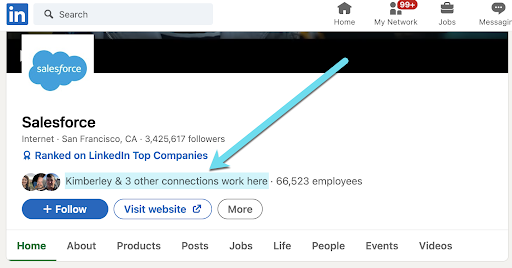
Another great tool to use here is Buzzsumo which allows you to find people who tweet on a topic of your interest.
Depending on the nature of your B2B business, you can play with smart metrics inside Buzzsumo to find Twitter users who engage with their followers:
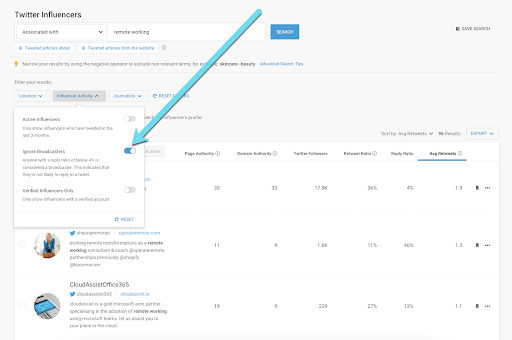
Finally, Twitter bio search tools like Followerwonk and (again, Buzzsumo) should be used here as well as they will find you to find people who mention your target company in their bios (as they likely work there):

Step 3: Research your competitors’ promoters
Another great way to find the right influencers is to identify who is promoting your closest competitors (or, even better, your past competitors who closed their businesses).
This is where good old backlink research is useful. SEO SpyGlass is a great tool to use here as they allow you to clearly see how your competitors are acquiring their backlinks and quickly find backlink gap opportunities — websites that are linking to your competitors but not you.
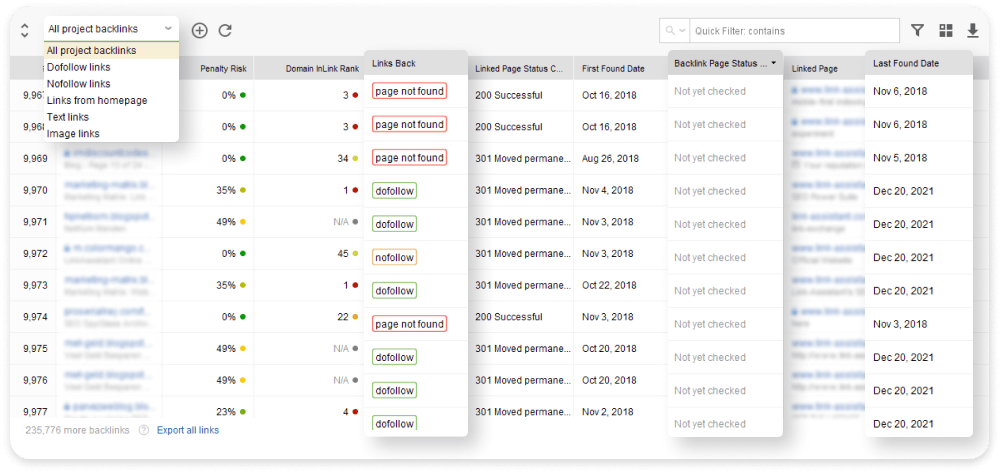
Another useful tactic to use here is social media monitoring as it will let you stay on top of your active competitors’ influencer management tactics. Awario is a great tool here because it has a handy boolean search feature allowing you to laser target your monitoring based on sources and purposes of your monitoring:
Step 4: Develop an effective outreach strategy
Once you have defined your pitches, start collecting your data for your outreach. It is a good idea to start a spreadsheet with your defined influencers, their target pitch, contact details (including their social media accounts), and any notes.
There are all kinds of WordPress solutions to share this document with everyone inside your organization.
Hunter is a great way to find the email addresses of your target influencers and website owners. They also have a handy Email Verifier for you to verify any contact details you manage to find.

This will save you time and money enabling you to use valid email addresses:
Email verification is your first step to creating a high quality email marketing database.
Step 5: Value those connections
This is the most crucial step: Your influencer marketing is never actually complete. You need to keep in touch with those influencers who chose to reply whether they agreed to work with you or simply sent a generic reply.
Keep talking to them on social media. Send them updates on your product development. Share your achievements and milestones.
It is not about bombarding them with your emails and social media messages. Only send them important updates that they may really find interesting.
It is a good idea to create a separate brand to consolidate your (hopefully) ever-growing community of influencers. This may be as simple as setting up a private Facebook group or as advanced as creating a new community-driven website.
BeRush is a great example of the latter: SEMRush is using this site to keep in touch with the international community of its affiliates. It includes a Q&A inside, product updates, as well as all kinds of materials to help their affiliates better position the product to their audience.

Namify is a great tool to find a great name for your community-driven project. There’s also a huge database of great business names they are offering as ideas:
Unite your whole company (your marketing, customer support, sales, product development teams) around one common goal: Keeping in touch with your influencers. Tying SEO and sales are the only way to make your B2B outreach strategy work.
Find the Right Influencers and Soar!
Finding the right influencers to help you sell your B2B product is a great way to create a consistent stream of new sales that won’t depend on Google’s algorithm whims or your advertising budgets.
It is also very rewarding because you get a chance to turn those influencers into advocates who will remain loyal for years and help you build brand awareness and improve your product. Good luck!
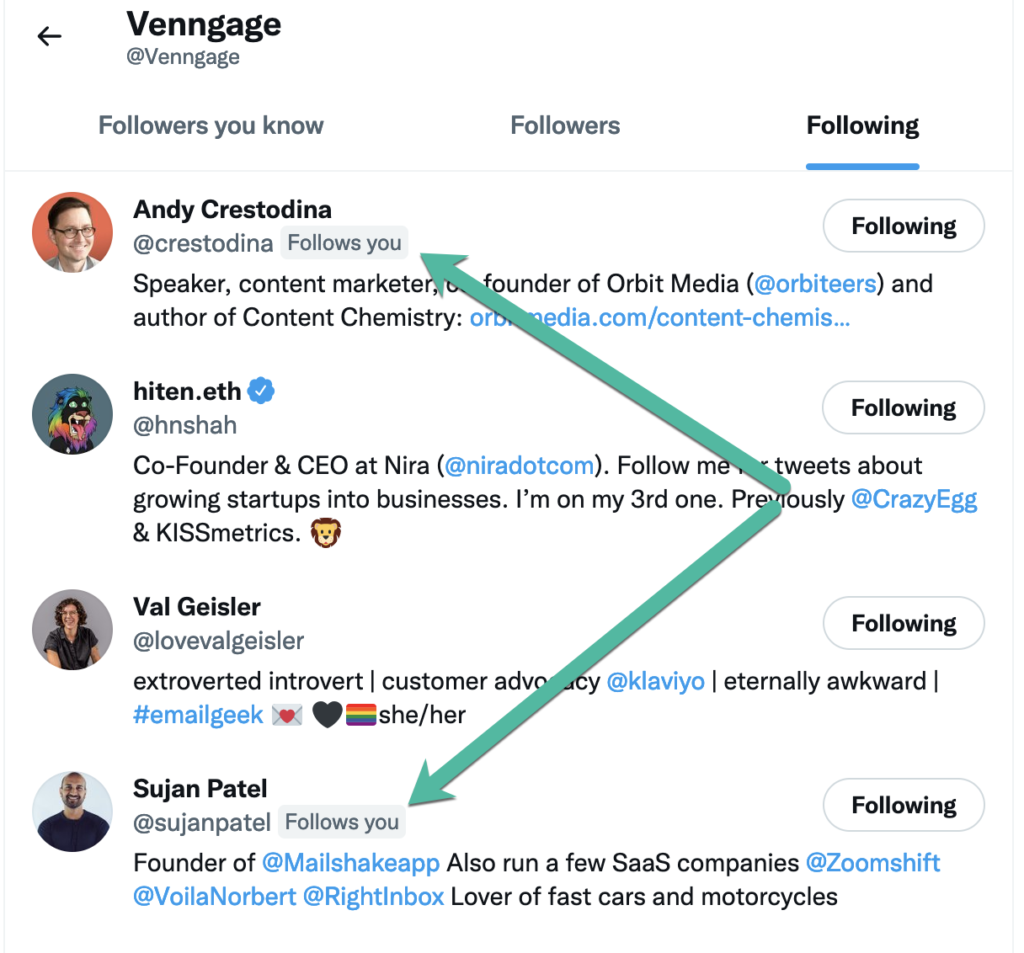
The post How to Identify and Win the Right Influencers to Promote Your B2B Product appeared first on Content Marketing Consulting and Social Media Strategy.
Source: convinceandconvert.com

Struggling With Customer Acquisition?: Fix This One Alignment Issue
You are struggling to hit your acquisition targets—the marketing team is bringing in lots of hot leads but the sales team is struggling to convert them. Yet your marketing team is an award-winning one and your sales team is world cup worthy.
Where is the problem with your customer acquisition strategy? And what can be done about it?
Let’s dig a little deeper to understand what is making your team of A-players struggle to hit your acquisition goals?
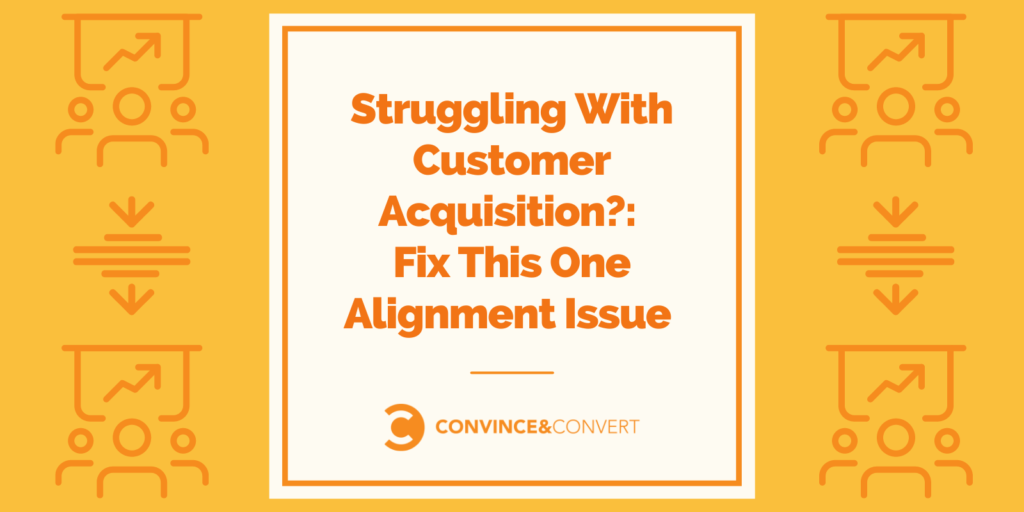
Why Does Your Customer Acquisition Strategy Seem Broken?
There are many reasons why your customer acquisition strategy may not be working. But deep down, it’s due to one thing: the misalignment between your sales and marketing team.
Here’s how it translates into the organization.
Gap 1: Your sales and marketing teams are working on different funnels
In most companies, the marketing and sales teams work separately. Too often, marketers know too little about the customers and their dealings with the sales team.
SDRs work on cold emails and cold call random people, and marketers run campaigns to their target persona. As a result, each of these departments ends up creating an acquisition funnel based on the persona they have identified as their ideal customer profile.
This strategy is still used by many companies, even by some industry leaders, and it enables them to fuel their year-over-year growth.
Now, I bet you’re wondering what the problem is since this strategy seems to work.
Well, a study by the International Data Corporation revealed that B2B companies’ inability to align marketing and sales teams around the right workflows and technologies costs them about 10% or more of revenue per year.
In fact, when your sales and marketing departments function as standalone departments, efforts are put into tasks that are not very productive. For example, one study found that 50% of sales time is wasted on unproductive prospecting—either chasing unqualified leads or trying to convert leads that aren’t yet warmed up.
Another consequence of sales and marketing teams working with different funnels is a lack of understanding of the Ideal Customer Profile to target. For example, a lead that the marketing team deems qualified may be seen as unqualified by the sales team. A study by ReachForce showed that sales reps ignore 50% of marketing leads.

Other studies have shown that 60-70% of B2B content created is never used. In most instances, this is because the topic is irrelevant to the buyer’s audience.
As you take it a step ahead, you realize that if the marketing team and the sales team worked together, it would have been easier for them to determine what content the marketing team should produce for lead nurturing and how to use it to warm leads.
Gap 2: Your sales and marketing teams are chasing different results
How can you achieve a shared goal if each team measures its success in different ways?
For clarity purposes, let’s assume you have a SaaS, and your annual goal is to grow sign-ups by 45+ percent.
Now imagine that the sales teams measured their success based on new free trial accounts, closed deals, and upsells. Meanwhile, marketing teams measured their success on lead quantity, quality, and brand awareness.
In this particular case, saying that you will fall short of your annual goal is just an understatement.
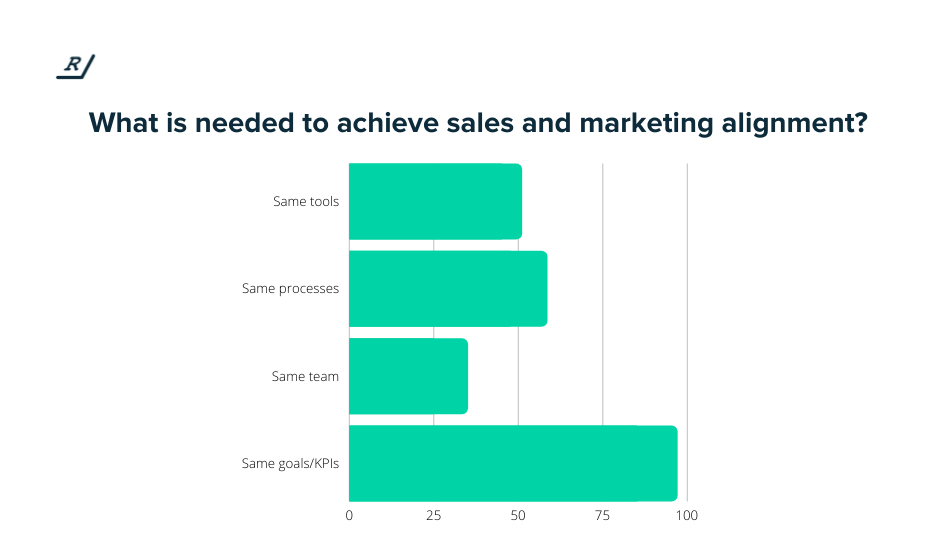
If there was alignment between the two teams, they would have agreed on what a quality lead means for the company and what is the average number of leads marketing needs to bring in before sales convert X amount of users.
If, for example, the metric shows that the sales team needs 15 leads to close 5 deals and that each of these leads should be SaaS companies with teams of 50 to 300, the marketing team will know where to focus their efforts and what to do in order to reach the common goal.
Similarly, the sales team will know better how not to fall short of the 5 out of 15 deals closed.
Why Aligning Sales and Marketing Is The Only Way to Fix Your Customer Acquisition Strategy
So with the gaps identified, it has become increasingly clear that the solution to bridging the gap is to align your sales and marketing teams.
Here are some reasons why.
It helps keep business to customer communications consistent
It happens more often than you think—the sales team calls the product one thing, but the marketing team uses another term to describe the same product.
For example, the sales team calls it a “Chatbot,” while the marketing team calls it a “Conversational Marketing Platform.”
Here is another example. The marketing team talks about “Collaborative Growth Platform”, while the sales team talks about “CRM”.
Admittedly, this can be confusing for potential and even existing customers, and it’s a living example of mismatched messaging.
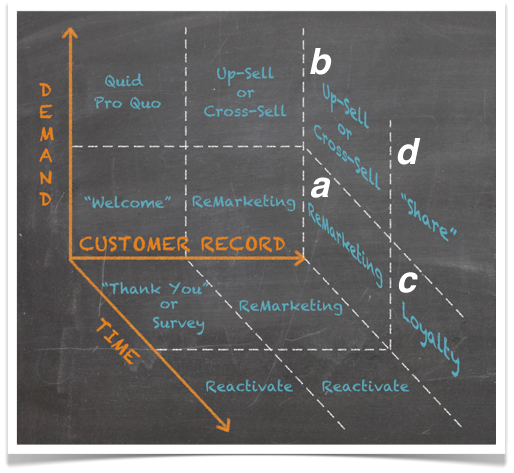
Not surprisingly, it can cost you your first good impression and, as a result, a prospect may be less likely to trust you.
In fact, 21% of B2B marketers cite “giving the prospect a bad first impression of our company” as one of the most damaging factors resulting from misaligned marketing and sales.
That’s why one of the biggest benefits of aligning sales and marketing teams is consistent messaging.
The messaging used by your marketing team can now warm up prospects and set them up for the sales team to further reinforce those same messages. If the marketing message strikes a chord, the sales team can use it to close more business.
Failing this, you may end up with a siloed message, which can lead to a very confusing and inconsistent journey for your prospect.
21% of B2B marketers cite “giving the prospect a bad first impression of our company” as one of the most damaging factors resulting from misaligned marketing and sales.Click To Tweet
If your prospects think they’re getting one thing based on what marketing is saying when the sales team is selling them something completely different, it will definitely hurt your bottom line.
So it’s important to make sure your message is consistent and relevant to your entire customer journey.
It creates a single customer journey
We discussed earlier that the foundation of the sales-marketing relationship is the conversion funnel.

So when it comes to getting everyone on the same page, the best place to start is to get them to agree on the structure of the entire customer journey.
By doing so, you save your prospects from having a single branded customer experience instead of separate siloed experiences.

As a result, everything is tied together as an experience—from the awareness stage at the top of the customer journey funnel to the brand loyalty stage.
It fosters a “marketing first” approach
Each department plays its own tune when your sales and marketing teams are misaligned. In such scenarios, prospects are less likely to respond positively to a cold outreach if they’ve never heard of you, and that can harm your reputation and your chances of closing the deal later on.
If both teams are aligned, it encourages a “marketing first” approach—meaning that marketers find prospects who have a specific problem and create content to help them solve that problem.
It all starts with the marketing team warming up and nurturing new leads by creating informational content about the product and selling the features and benefits by creating transactional content to fuel conversion.
Then, when the potential customer prepares to make a decision, the sales team can take it from where the marketing left and close the deal.
It leads to a better way of assessing results
By aligning your sales and marketing teams with a common goal and the same KPIs, you have a great chance to see the synergy behind their work and analyze how your organization is stacking up in both sales and marketing.
In addition, you will be able to detect the shortcomings of your customer acquisition funnel and adjust not only certain parts but the whole funnel.
The post Struggling With Customer Acquisition?: Fix This One Alignment Issue appeared first on Content Marketing Consulting and Social Media Strategy.
Source: convinceandconvert.com

Fuel Marketing Transformation with Team Alignment
The Pain Points of Misaligned Teams
Anyone who’s worked on a team knows what it feels like to be part of a team that isn’t aligned, and this can have a real impact on your ability to make strategic improvements. Does this sound familiar?
- Your organization has invested in and developed strategy after strategy, but none of them are sticking; execution is a real challenge.
- Teams aren’t working well together and the silos between teams are cementing into territories that are heavily guarded – resource and information sharing is forced, rather than the norm.
- Leaders keep getting feedback from their teams that they need more headcount to do the work.
- Team members aren’t bringing their best – no breakthrough creative ideas, less innovative problem solving, fewer examples of working “above and beyond.”
- It seems like team members don’t enjoy coming to work – there are complaints that the day-to-day work is frustrating, a total grind, or unmotivating.
- Teams are experiencing high turnover from people that seemed at least moderately satisfied at work.
I imagine you’re nodding your head and also feeling a growing apprehension about the big plans you have for the coming year.
For many of you, a new strategy, campaign, or initiative is on the horizon and success is the only acceptable outcome. You’ve likely tried implementing change in the past with less-than-ideal results.
The issue is likely a mix of individual motivations, team culture, tools, and resource gaps that internal leaders are having difficulty parsing out and addressing.
But there is a better way: when team members actually trust their team, know-how to point out flaws, and learn from each other to co-create the strategy, inevitably objections and silos dissolve, enthusiasm skyrockets and entrepreneurial thinking abounds.
Team Alignment is a Predictor of Success
This just in: Leading business researchers have discovered a revolutionary new approach that makes any business more profitable. It reduces costs and increases productivity and profitability. It increases lead quality, pipeline velocity, leads to happier customers, and more repeat business.
Companies using this approach also have more satisfied employees, are willing to work harder (often for less money!), and have higher overall employee retention. It has no hard costs and you can do it internally, with resources you already have. Are you interested?
Any business leader would be negligent not to at least open that link and try to figure out if it was too good to be true.
When they come to realize the research was conducted by Google, Harvard Business School, and dozens of reputable sources consistently since the mid-1990’s you’d expect that they’d be adding this new approach to the very top of their to-do lists and retraining managers to incorporate the findings.

Team alignment, and its the underlying foundation of psychological safety, is not something that should be relegated to HR or written off as “soft skills.”
In almost two decades of writing and overseeing strategic marketing transformations, I can say with confidence that team alignment is the number one indicator of whether a new initiative will succeed or fail.
Unfortunately, it’s also a topic many leaders would rather gloss over when they get ready for a big strategic change – they want action plans, not “warm and fuzzy” team alignment plans. I’ve had pushback more than once from clients who would prefer we “stay in our lane” and just focus on research, metrics, and action plans.
Research Shows Aligned Teams Are Critical

When you ask most business leaders about team alignment and psychological safety, they often point to the HR department, mumble something about the culture, and shrug their shoulders. This is too bad because the research is clear:
- Companies that successfully align sales and marketing retain 36% more customers, generate 32% higher revenue and achieve 38% higher win rates. (Source: Ascend Ebook)
- A study of 1,000 professionals across a range of industries found teams with cross-functional collaboration and an openwork style are 60% more likely to achieve more, faster. Plus, they’re 80% more likely to report high emotional well-being. (Source: Ascend2)
- More than half (54%) of employees say they’re willing to stay at a company longer than what’s in their best interest due to a strong sense of community. (Source: Ascend2)
- Google’s “Project Aristotle,” explored over 250 team-level variables, found that psychological safety is the most critical factor and a prerequisite to enabling successful teams. (Google, 2015). Team psychological safety is a shared belief that people feel safe about the interpersonal risks that arise concerning their behaviors in a team context (Edmondson, 2018).
- Despite the importance of psychological safety, only 47% of employees across the world described their workplaces as psychologically safe (Ipsos, 2012).
What’s Team Alignment and Psychological Safety?
Team alignment can feel hard to pin down if you’re new to the topic but here’s a simple definition: team alignment is the team’s ability to work together and learn from each other.

As researchers have tried to study and measure this trait, they have settled on the term “psychological safety” and defined it as having four key domains or areas that can be assessed:
- Attitude to risk & failure: does the team see failure as a necessary byproduct of growth and innovation? Or is it punished and avoided at all costs?
- Open conversation: do team members feel comfortable expressing concerns and reservations as they work together? Can they learn from one another and hear constructive feedback in the spirit it is intended for?
- Willingness to help: Does the team have a spirit of being “in this together” and do they easily pick up slack for the benefit of the whole? Does this shake out fairly or do some team members take advantage of others?
- Inclusivity: Does the teamwork hard to ensure all perspectives are represented, even from those who are not always first to speak?
Roadmap for Successful Change
Let me give you the shortcut formula to planning your success. Every single business transformation comes down to two simple questions:
- What exactly do we need to do differently?
- Who is going to do it?
The first item is your strategy, and companies are always paying for more and better strategies. Unfortunately, all too often they completely ignore the second item, assuming that once the WHAT and HOW are clear, the WHO will fall into place.

A plan can be strategically sound, backed by data, and make perfect sense on paper but that doesn’t mean the team will get on board. Considerations like who gets credit, who will benefit from less work or more resources, job security and perception of rank, and how success is measured all inherently affect the buy-in for any new plan.
STEP 1: Strategic Alignment – What exactly do we need to do differently?
- Define what you’re trying to achieve, clearly, concretely, with metrics.
- Link the change to a larger organizational vision
- Specifically define the change: current state, target state, the gap, and what is NOT changing.
- Identify past lessons learned. What has been tried before and how did it go?
It’s worth noting that most teams are pretty good at step one, but they stop there.
STEP 2: Stakeholder Analysis & Team Alignment – Who is going to do it?
- Ensure the team agrees on the problem and its urgency
- Confirm the team believes change is possible in this setting.
- Ask whether the team has the time, energy, and willingness to change. (Change fatigue is real!)
- Uncover whether each individual believes they can personally succeed with this change
Team Alignment In The Wild
For the last couple of years, Convince & Convert has worked with a large national association ($1.7B in revenue, 38 million members) on a wide variety of marketing initiatives. One change, in particular, was in process when we started working together, and the outcome was anything but certain.
A new project management system was intended to be a centralized place for updates and tracking, intended to increase collaboration, reduce meetings, and allow workloads to be distributed more evenly across the team.

Unfortunately, team adoption of the new tool was low and falling farther – the grumbling was increasing over time. Leaders in charge of its success were struggling to come up with a way forward. Confidential interviews with individual team members uncovered some real and specific challenges, both with the actual tool and how the change was communicated.
Owners of the tool went back to developers to overhaul the tool and improve functionality, and are in the middle of a much more successful rollout with an enthusiastic reception from previously reluctant team members.
Setting Up New Norms
In another example, a nationally-recognized, top-50 university we worked with was struggling after some changes to the marketing team organizational chart and reporting structure. Two teams that had previously been independent were combined, but the merger was not a smooth one.
Assessments of the team showed that each smaller team felt psychologically safe to communicate openly. However, when the teams combined to collaborate, that index score went way down. The norms of each smaller team were different.

They needed to be revisited to openly agree on what type of feedback was preferred, how to run meetings, and a number of other patterns that develop almost without noticing but need to be identified, agreed upon and communicated to new team members.
Once new norms were established, the teams were able to work together fluidly and begin finding the synergy that was intended with the original combining of teams.
“What’s in it for me?”
It’s important to dig in here and get curious to understand team strengths, weaknesses, passions, and drains. This often means closed-door confidential sessions where team members have a safe space to talk about their ambitions and concerns, what skills they do or don’t possess, and where they might like to grow.

The effort is not the same for everyone; work to understand perceived effort with perspective taking, empathy, mentoring, coaching.
Smart leaders understand that all change in responsibilities comes with a power shift across a team. When changes are on the horizon, the first question everyone wants to be answered is, “how will this impact me and my job?”
- Who on the team will have to learn new skills?
- Whose job might be in jeopardy after the change?
- What new resources will various team members get? How do I get my share of the pie?
- Will the extra responsibilities be rewarded fairly?
- If the new work sounds fun, can I get rid of some old tasks I hate?
…and dozens more
Answering these questions in advance, equitably, and with your individual skills and goals in mind is the core job of a great manager. Allowing the team to negotiate among themselves, speaking honestly about their strengths and weaknesses, skills they have or want to develop, and how they’d like to see the change unfold is the gold standard.
How Does Your Team Rank?
These areas are so critical to navigating change, and more and more of our clients are interested in getting better, not just at the “what should we do to innovate?” question but also understanding the people and motivations that will make or break the strategic plans they’ve laid out.

A seven-question assessment that takes under 3 minutes can help teams understand their ability to bring new ideas and challenge each other, essential qualities of a successful organizational change process.
Benchmarking the team’s score and growth over time can provide tangible, actionable goals for managers and teams to work towards. The Convince & Convert team has strategists trained to conduct these assessments and facilitate improved team alignment, and we’d love to help your team on the next stage of your journey.
The post Fuel Marketing Transformation with Team Alignment appeared first on Content Marketing Consulting and Social Media Strategy.
Source: convinceandconvert.com

Why You Should Still Be Using Personalized Marketing to Boost Your Brand
It’s getting harder than ever to connect with buyers and prospects on a personal level.
The good news? It is easier to build real, human connections with your audience if you know what data and strategies to use.
One of the most effective strategies to build a personal connection is personalized marketing.
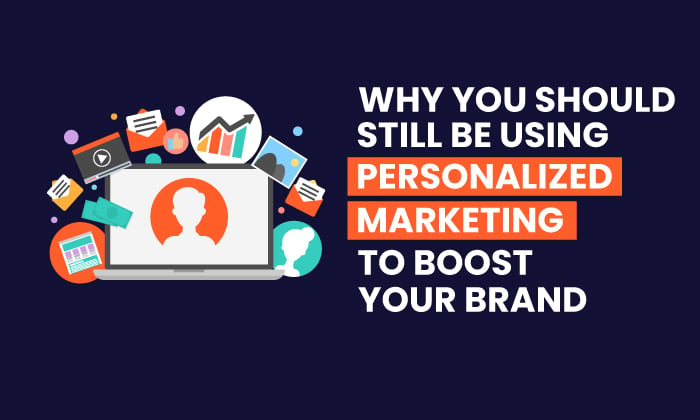
What exactly is personalized marketing, and what are the benefits? (Hint: It’s more than adding “$FNAME” to your email marketing!)
Here is what marketers need to know about personalized marketing.
What Is Personalized Marketing?
Personalized marketing is a strategy that uses demographic and behavioral data to create individualized messages for current or prospective customers.
It’s incredibly popular, with research from Statista showing that 78 percent of marketers use personalized marketing in their email marketing alone. Most marketers use the strategy on multiple channels.
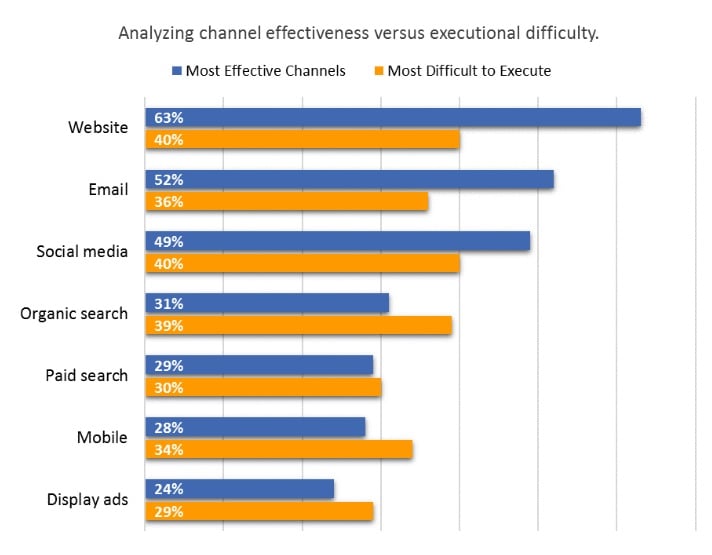
The point of personalized marketing is to understand your customers more and how they like to communicate so you can better engage them in the busy online world.
There are three main categories of personalization: behavioral, contextual, and demographic.
- Behavioral personalization analyzes customer interactions with your company, such as past purchases or website behavior.
- Contextual personalization considers where customers are in their journey.
- Demographic personalization examines demographics like age, gender, race/ethnicity, and household income level.
Companies have used personalized marketing for years to improve engagement rates, but factors like the growth of AI and data analytics are making it easier than ever for even smaller companies to get on board.
Personalized marketing is also one of the best ways to engage customers between channels and send more relevant marketing messages.
Different Types of Personalized Marketing
Before we dig into all the benefits of personalized marketing, it’s worth looking at the different types of personalization. Keep in mind that different approaches might be more effective based on your audience, industry, and business model.
There are four main types of personalized marketing. Let’s look at them one by one.
Segmentation
This is a technique marketers use to divide their list into smaller groups or segments.
Segmentation helps brands to understand their customers better and target their products accordingly.
You can implement email segmentation by analyzing the customer data and behavior over various channels to deliver the content and style most valuable to your buyers/prospects.
You can also use segmentation to identify where the customer is in their journey or to encourage sales.
An example of email segmentation in action is Sephora.

The beauty brand sends out segmented emails to remind customers to restock on items they’re likely running low on. Sephora’s approach nudges buyers into heading over to its site and getting the product.
Further, Sephora makes it almost effortless for customers to repurchase; they’ve just got to click on the message and it takes them right to the item.
Segmentation can also be used to deliver personalized content, lead magnets, paid ads, etc. Essentially, the goal is to separate your audience into segments and deliver more relevant messages.
Personalized Emails
A personalized marketing email is an email that aims to address the personal needs of a recipient the company has had some kind of previous interaction with.
Companies send personalized emails to buyers or to prospects who have shown an interest in certain products. Typically, these emails go further than addressing the customer by name. For example:
- they personalize subject lines
- companies send them to welcome new customers and acknowledge orders
- they target consumers who’ve abandoned carts
For further personalization, businesses can use their data and track consumers’ behavior to tailor the emails and increase the chances of a purchase.
A popular use for such messaging is product recommendations, like this one from Groupon, which focuses on pampering experiences a customer may appreciate.
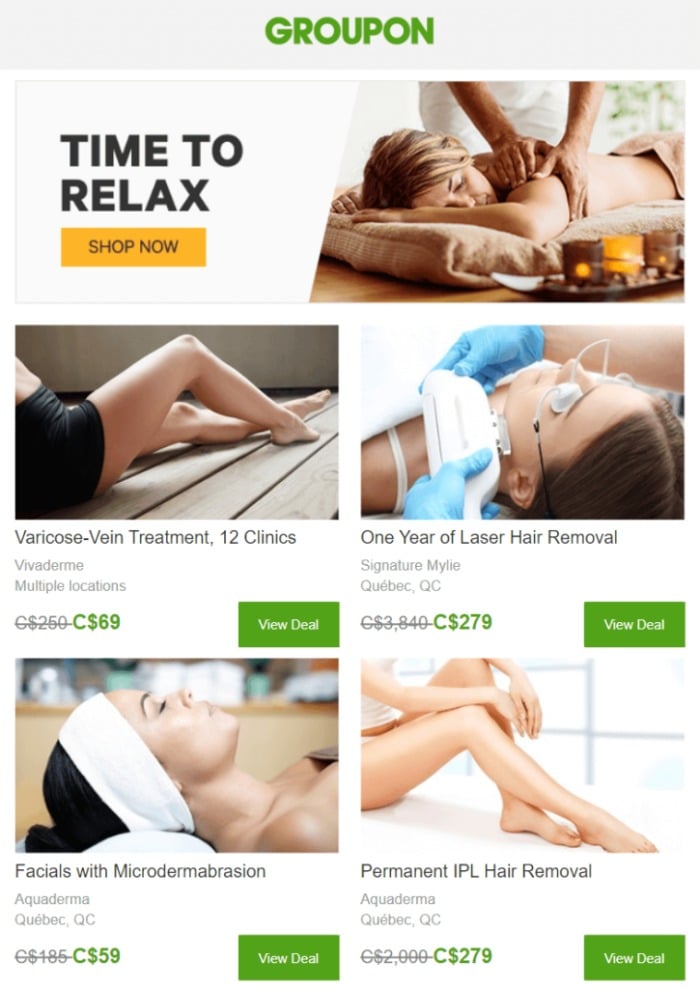
Dynamic Websites
Dynamic websites are a form of web design that relies on real-time data to provide a personalized experience.
Most often, businesses use them to create engaging customer experiences in a way that is more meaningful and personal to the individual.
An example is dynamically adjusting a webpage to display specific categories or products first.
Travel companies might also use dynamic websites to adjust their homepage to focus on the city a visitor has researched:
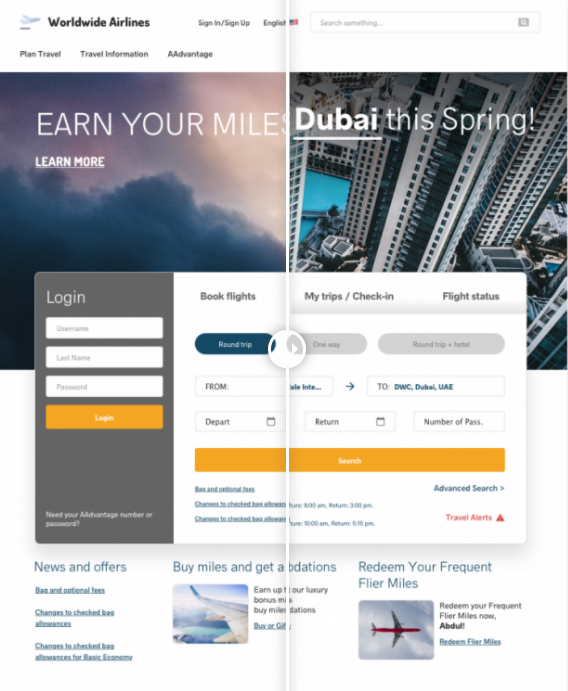
The homepage to the left is the site’s standard homepage, while the right side shows to a visitor who has researched flights to Dubai.
One-to-One Personalized Marketing
One-to-one personalized marketing is all about reaching out to a customer. It’s more than just sending emails to the same group of people: It’s about creating tailored content for each individual.
This approach takes personalized marketing to a new level and puts the focus on data, like:
- demographics
- geographical locations
- devices they’re using (Smartphone, laptop, etc.)
- past purchases
Businesses then use all this info to make specialized discounts like the one below or offer other incentives to get a prospect over the sales line.
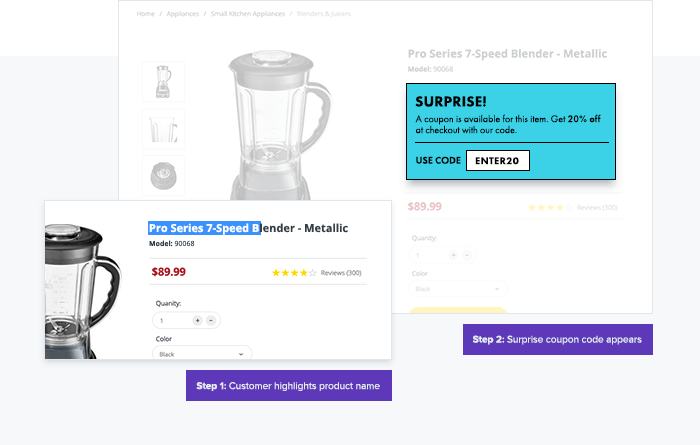
Product Recommendations
We’ve all seen the emails or ads you get after you’ve purchased a product or used a service from a company.
For instance, when you buy or search for something on Amazon, you get messages like “more top picks for you,” “your browsing history,” or “keep shopping for.”
Like one-to-one personalized marketing, product recommendations use behavioral data, such as purchase and search history, to deliver personalized recommendations.

For example, a razor company might see you purchased a razor a few weeks ago and recommend a shaving cream.
What Are the Benefits of Personalized Marketing?
One of the main benefits of personalized marketing is that it is more affordable. Messages are more direct, which means you spend far less time (and money) targeting users that aren’t likely to convert.
However, that’s not the only benefit.
Customers Prefer Personalized Messages
According to a report by Smarter HQ, 90 percent of consumers are willing to share personal data for an easier or cheaper brand experience.
An Epsilon survey found 80 percent of consumers are more likely to do business with a company if it offers personalized experiences—and 90 percent say they find personalization appealing.
Buyers like brands to treat them as individuals and respond to their pain points. Personalized marketing does that, and tailored campaigns and follow-up emails make your customers feel valued and appreciated.
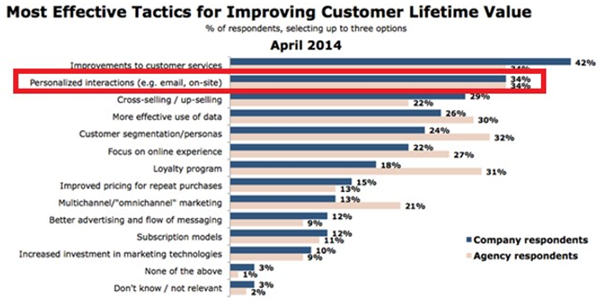
Better Understand Your Customers
You already know how to gather information like demographic data, search and purchase history, and social media activity.
However, AI and marketing automation technologies enable marketers to gain an even better understanding of who their customers are and what they need. For example, you might find that high-revenue customers prefer a specific channel, like email.

Digging into the data for personalization gives you more insights into who your customers are, what they want, and what will drive them to make a purchase.
That data can be used to improve other marketing strategies, inform rebranding, and much more.
Improve ROI of Marketing Efforts
Personalized marketing is a simple way to improve your overall marketing ROI by providing what the user wants.
In fact, personalized marketing can reduce acquisition costs by as much as 50 percent.
Here’s more proof: HubSpot found personalized CTAs perform 202 percent better than basic CTAs.
Additionally, it’s a way to build customer loyalty and brand recognition while reducing your acquisition costs.
Improving your ROI starts with your data to produce accurate customer profiles to create relevant content and offers for them.
A great example of this is McDonald’s.
The fast-food giant took things a step further than most by acquiring AI firm Dynamic Yield to personalize digital menus. Later, Mastercard purchased Dynamic Yield from McDonald’s to further improve their customer experience.

As Raj Seshadri, President of Data & Services, Mastercard, puts it:
The notion of going into a store or opening a webpage to find an experience perfectly tailored to you is no longer farfetched. It’s a reality that more brands are deploying and more consumers expect.
While most of us don’t have McDonald’s or Mastercard’s budget, you can still use personalized marketing to get results by relying on data from first-party tools that track users on your site or tools like HubSpot.
Increase Customer Engagement
Every company strives for more customer engagement, and personalized marketing helps you get there. It all begins with understanding your customer base in terms of demographic, psychographic, and behavioral data and tailoring efforts for each individual.
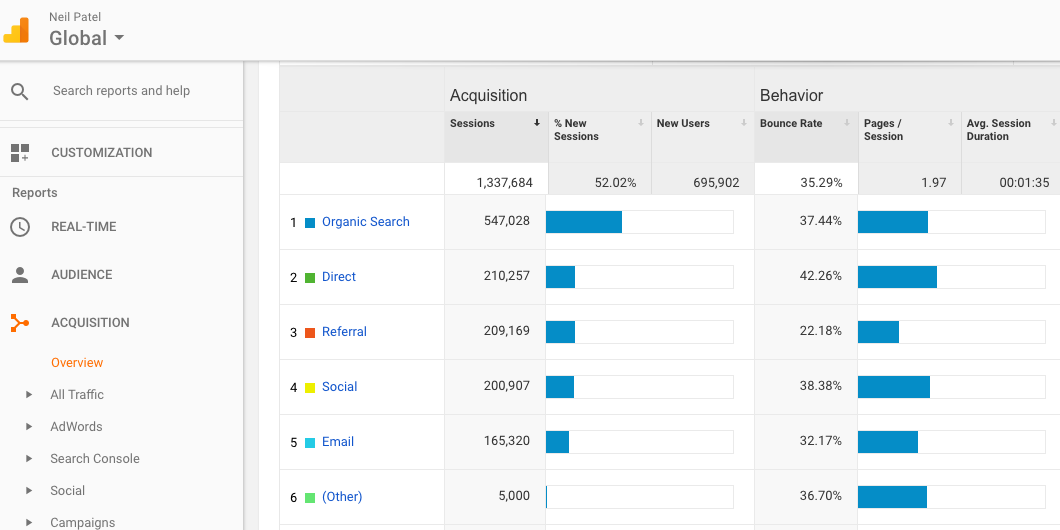
In practice, that means:
- knowing your customers’ expectations
- taking an omnichannel approach
- analyzing your data
That data can be used to speak directly to users on their preferred platforms about the topics important to them.
When you succeed at customer engagement, the rewards are priceless: Loyalty improves, revenues increase, and your business grows along with consumer trust.
Improve Customer Retention
Personalization makes it easier to identify your customers’ needs and provide them with solutions that will solve them—and that increases retention.
As a McKinsey report explains, when brands use customization correctly, they do more than just survive; they thrive.

Plus, 60 percent of customers say they’re likely to repeat if a brand offers personalized interactions.
With numerous personal touchpoints at each stage of the customer journey, sales increase, and customers stay loyal.
That’s a win for your customer and your brand.
Enhance Email Open Rates
Email open rates are the metric most email marketers focus on, and with good reason: if your list isn’t opening your emails, you’re not making any money.
There are many ways to improve your email open rates, such as:
- personalize your email content through segmentation adjust your content so it’s relevant to the readers
- send emails at the right time of the day
- adjust your CTAs to be more appealing
By using personalized marketing methods, you can increase your email open rates dramatically.
However, it’s more than ensuring you have your customer’s name in the subject line. It’s also about providing personalized discounts while creating headlines, snippets, and content that connects with them personally.
When you do this, customers feel like you understand them and what they want.
Personalized Marketing Frequently Asked Questions
What are examples of personalized marketing?
Personalized marketing examples include a dynamic website that adjusts content based on user behavior or product recommendations that are generated based on past purchases.
How do I get data to use for personalized marketing?
The most common way to get information for personalized marketing is through your existing customer data from social media platforms like Facebook and Twitter. Alternatively, you can use third-party tools like Google Analytics, Adobe Analytics, or Marketo to aggregate customer data from different sources.
What tools can I use to personalize my marketing?
Tools to help with marketing personalization include HubSpot, OptinMonster, and Evergage. Here’s a full list of tools to consider.
Why is personalized marketing important?
Personalized marketing is imperative because it improves customer engagement and generates higher conversion rates. It also provides a better customer experience and develops deeper relationships with your audience.
Conclusions: Personalized Marketing
Personalized marketing is a powerful tool for marketers and business owners. It has an increased ROI and leads to higher conversion rates.
A personalized marketing campaign also increases customer loyalty by creating that personal connection with them, which makes them feel valued and appreciated.

By focusing on what is most relevant to the individual, there is a higher chance of them making a purchase than by only sending an email packed with generic information that doesn’t apply.
Although personalized marketing may be time-consuming, it’s well worth the effort to grow your business.
Do you use personalized marketing? How has it transformed your business?
Source: neilpatel.com

How to Align Your SEO and Sales Teams
Have you figured out your marketing strategy for 2022 yet?
Here’s a great idea for you: Embrace collaborative marketing. Aligning your different teams is likely to open up many new opportunities for your business.
According to the recent research by Convince and Convert and Ascend2, 50% of marketers claim that integrating marketing and sales teams has proved to be very successful at achieving strategic goals.

This is huge.
Here’s how to align two of your most isolated teams: Sales and SEO.
Foster Content Marketing Collaboration
All marketing is driven by content and that includes SEO and sales. For both teams, content is fundamental. Without content, there are no rankings or sales:
- Google relies on content to identify if a page is relevant to a search query and if it satisfies a searcher’s intent. Relevancy and search intent are two key ranking signals.
- In sales, content is the most important driving force behind buyers’ journey. Content can directly impact purchasing decisions, as many studies confirm.
According to Forbes, more than 60% of B2B buyers say they are able to make their purchase decision exclusively based on digital content, without talking to sales reps or going through demos.
So why is there such a huge disconnect between SEO and sales content? Why do these two content strategies often exist separately without informing or helping each other?
“Content is King” has long been a marketing buzz phrase, especially in the B2B industry. However content is only King if it enables sales.

Too often there’s a discrepancy between those producing content and organizational teams who are trying to leverage it.
The resulting problem is two-fold:
- Sales reps lack the right content they can use to effectively engage with prospects
- SEO content creators lack sales reps’ insight which would enable them to create content that addresses the real struggles of their target audience.
Ways to Integrate SEO and Sales
Content can be the driving source for removing your organizational silos and encouraging cross-team collaboration.

How can SEO and content marketing teams collaborate on creating an integrated content strategy?
- Encourage the two teams to brainstorm on content ideas together
- Let the customer support and sales teams keep a shareable record of questions your actual customers are asking them. Any of those can and should be content ideas for the SEO team to research in terms of demand (search volume) and difficulty.
- Foster creativity from both of the teams: What are their thoughts on content promotion opportunities.
- Do they have any viral content ideas?
- Let both the teams explore further opportunities. For example, let your SEO team figure out ways to reuse sales enablement content for ESP purposes. Many of those sales demos can be used as public content that can target all kinds of long-tail ranking opportunities.
Help Them Understand Your Customers Better
When you work on traffic numbers all day, it is too easy to forget that there are real people behind those numbers.
Both SEO and sales team have unique access to valuable insights on who is your business’s target customer and how to serve them better:
- Sales teams talk to your current and future customers on a daily basis. They know their struggles and what they are looking to solve. Sharing this information with the SEO team will empower your SEO strategy with more data your competitors have no access to.
- Your SEO team knows exactly what your customers are searching for and which questions they are asking. They know the demand behind each search term and they can report on how your competitors are targeting each search query.
Text Optimizer allows you to better understand concepts behind any search query and help you find the ways to meet your customers’ needs easier:
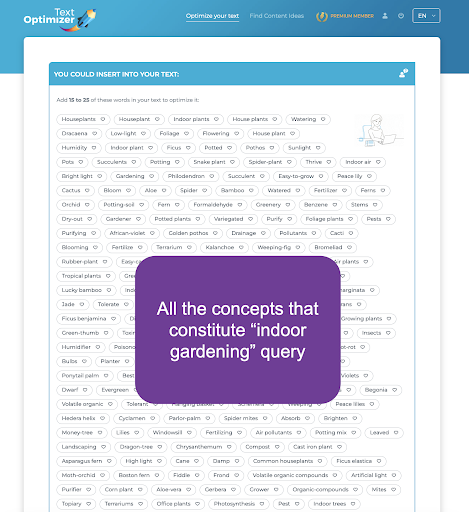
Share Your Web Analytics Insights
Let the SEO team share their web analytics insights: What are the effective paths that bring those leads through the site down the conversion funnel? What works best in terms of engaging your site visitors and turning them into leads?
All of that information will help your sales team focus on what works best and nail their lead generation and onboarding strategy.
Encourage your SEO team to create custom analytics dashboards and hold regular meetings to give. This will give your sales team access to web analytics data they can understand.
Google Analytics is the first option that comes to mind. But there are also web traffic statistics solutions offered by your hosting provider, as well as many Google Analytics alternatives.
Whatagraph is an easy way to create custom reports that are delivered weekly and are very easy to understand even for a non-technical person:
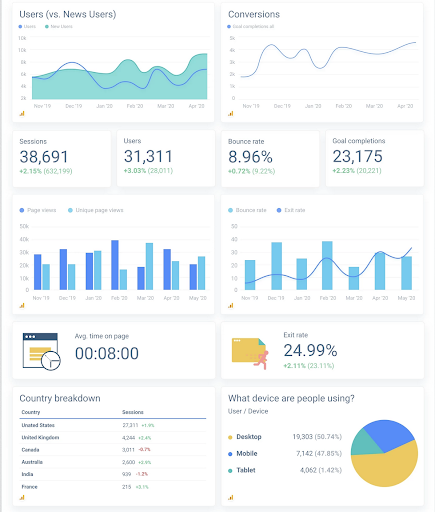
You can also integrate your web analytics into your website dashboard using these templates to let your whole company access it at any time.
Open up More Business Opportunities
The cross-team collaboration will likely discover more unexpected opportunities for you and your business. For example, letting your sales team access your SEO data may help them identify industry gaps and define your product’s unique value proposition.
You can also discover new product or service opportunities. For example, this SEO lead generation tool can help you expand your services pretty easily.
Widgets like this help integrate SEO into the sales process in the most efficient way.
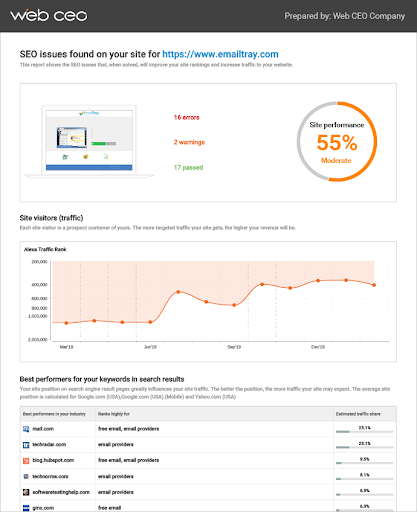
Conclusion
The power of cross-team collaboration is almost limitless. SEO and Sales collaboration can give you that competitive advantage your business needs. By combining numbers with actual sales experience, you can empower both teams.
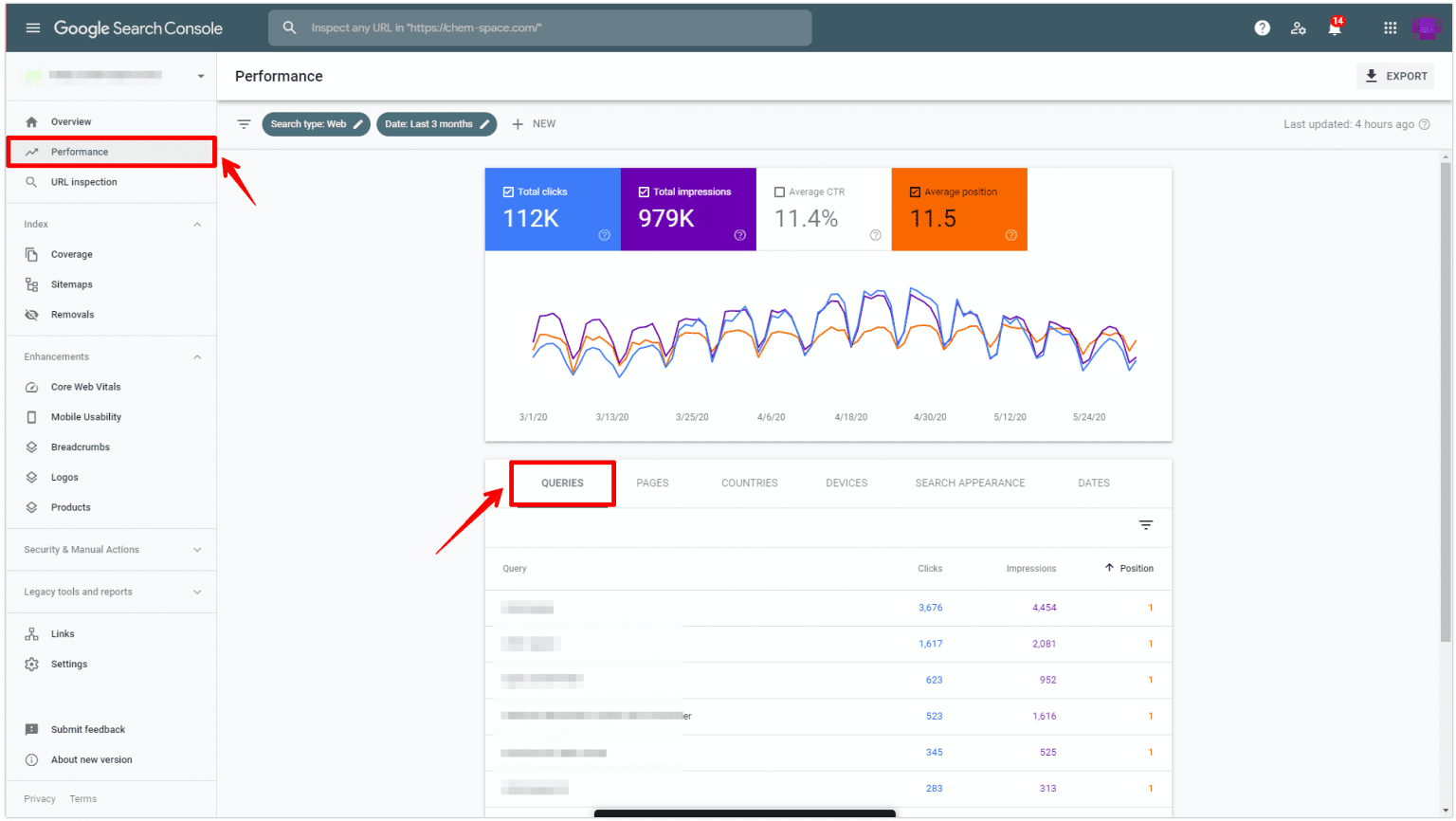
The concept of unified communications has become even more important for business survival after COVID hit and many teams moved to work from home.
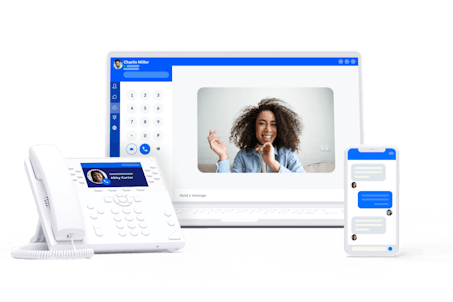
Finding more ways to let your (remote) teams keep in touch and collaborate is more important than ever.
Hopefully, the above ideas would come useful!
The post How to Align Your SEO and Sales Teams appeared first on Content Marketing Consulting and Social Media Strategy.
Source: convinceandconvert.com


